Executive Summary
The concept of brand awareness and Customer Relationship Management are essential means to facilitate the active business lives to impress absolutely its customers. The aim of this paper is to assess how brand awareness and brand loyalty can stimulate customer involvement and to examine how these theories dominate the business of Zara Fashion.
The literature review deals with the theories on the concerned issues of brand awareness, brand loyalty, the impact of integrated marketing communications on the company, stimulation of customers’ involvement in purchasing intention of a brand and so on. However, the present dissertation is highly concentrate Zara’s marketing strategies as the risk of decreasing sales and reducing profit lead the companies to restructure their strategies to sustain in the competitive market.
Problem Statement
Introduction
The purpose of this dissertation is to investigate how brand awareness and brand loyalty encourage customer’s involvement achieve the organisational objectives where Zara Fashion Retailer has been taken as a case study of. However, this dissertation will organise with six chapters, such as –
- Problem Statement: This chapter will concentrate on the background of the problem, justification of the research, overview of the selected company “Zara Fashion”, raises the research questions and mention scope of the study.
- Literature Review: This chapter should include theoretical framework to find out the relationship between brand awareness, brand loyalty, customer relationship management, and impact on sales, customer involvement and so on.
- Research Methodology: This part of this dissertation will provide a clear perception about the research method to formulate the research, process of data collection, designation of questionnaire, selection of respondent groups and data analysis process and limitation of this study.
- Findings and Result: Chapter four of the dissertation is one of the most interesting and important chapters as it will analysis the collected data and provide the result of the survey in accordance with the prescribed research approach.
- Discussion: This chapter of this study will organise considering the research question, such as it will describe Zara’s marketing strategies to develop brand awareness and customer loyalty;
- Conclusions: Finally, the chapter six will scrutinise all the discussion of previous chapters to draw significant conclusion and to provide recommendations.
Background of the problem
The ultimate objective of most business organisations is to increase profitability and competitiveness, which not only guarantees shareholder value, but also ensures the survival and growth of organisations in shifting business environment (Sahay & Sharma, 2010). However, Keller (2009) pointed out that boost of 5% in customer loyalty could lead to increase customer profitability by 25% to 90%, but many companies in fashion industry have not yet taken any measures to adopt this strategy due to lack of knowledge.
However, Zara is one of the biggest global fashion retailing businesses that belongs to Inditex, one of the globe’s major distribution groups; the purchasers are the key group of its exceptional trade-model that comprises invention, manufacture, allocation, and sells throughout its widespread retail stores. Inditex is a global specialty retailer that designs, manufactures, and sales apparel, footwear, and accessories for women, men and kids through its stores around the world, whilst Zara is the largest of the six retailers that Inditex owns (Zara, Massimo Dutti, Pull & Bear, Bershka, Stradivarius, and Oysho); consequently, by 2001, Zara opened 507 stores around the world, including Spain.
Out of Inditex’s entire workforce, more than eighty percent are part of the retail sales force while 8.5 percent are in manufacturing, design, logistics, and distribution; conversely, the rest 11.5 percent are part of the corporate headquarters of Inditex that has situated in the area of Spain known as Galicia.
However, the competition is more intense in case of fashion industry, because brand awareness and comprehension have achieved more significance among fashion consumers. In addition, fashion products serve the basic function of enhancing the personal appearance and style of customers, thus Zara represents a type of product category in which the customers are more likely to be actively involved in both the purchase and usage of the products according to their tastes and preferences (Kabiraj and Shanmugan, 2011). Therefore, this dissertation would describe Zara’s strategies to develop brand awareness to increase annual sales revenue and competitive advantages, as many competitors have no concern on this aspect.
Successful brand awareness has created when a business becomes able to establish a brand effectively and competently, which can constantly grab the attention of any person and settle on anyone’s minds such that whenever he or she wants to purchase a product of that category, the name of that brand comes to mind first. The customer has so engaged with the brand that the same product from any other company may not suffice to satisfy the needs and wants of the customer.
By creating such a brand awareness, the business will be able to successfully build a situation where the customers will become so connected with the product that they would start to call the brand name as the product category (for example, when people called all colas as Coca-Cola), resulting in creation of a generic brand. Under such a condition, the brand loyalty will be stimulating the customers’ involvement with the product of service.
Rationale for the research
Many researchers have researched to find out the answer of the question why consumers purchase a certain product and how marketing influence customer to purchase, but there is no influential research that deal with how can brand awareness and brand loyalty stimulate customer involvement. From last era, the scholars researched on the motivational factors such as customer relationship management, customer involvement, loyalty of the customer, and brand image to measure the impact on the profitability level.
The rationale of this research is to analysis the extent to which the brand awareness and brand loyalty effective to retain customer and increase profits by observing the real scenario of Zara Fashion. According to the view of Casalo, Flavian, and Guinaliu (2008), customer involvement is a necessary precursor to the establishment of long-term mutual relationships between the organisation and consumers. In this context, the aim of this study would profoundly assist fashion companies to boost their sales, enhance competitiveness, and maintain high customer satisfaction levels by developing a marketing mix that utilises brand awareness and brand loyalty initiatives to stimulate more customer involvement.
Research question and objectives
The proposed study will be guided by the following research questions:
- What are the strategies that Zara’s marketing division uses to effectively link brand awareness and customer loyalty to customer involvement?
- What are the industry’s best practices in improving customers’ perceptions towards more involvement?
The overall aim of this particular study is to critically evaluate Zara fashion retailer’s marketing initiatives with a view to develop an all-inclusive marketing framework that primarily considers how Zara can use its brand awareness and brand loyalty initiatives to further stimulate involvement among adolescent consumers. However, this paper emphasis on the following objectives –
- The objective of this research is to evaluate the Zara’s brand awareness and brand loyalty campaigns those targeting the customer group of 16 to 35 as this is the largest target market of Zara. It also assesses current trends or involvement of major consumers of fashion products;
- In addition, it will identify Zara’s marketing strategies, specifically brand awareness and brand loyalty strategies, then critically evaluate how these strategies can be better aligned to trigger processes and behaviours that support and enhance customer involvement;
- It would critically evaluate the perceptions of the young, and educated target consumers on the marketing initiatives of the competitors;
- This paper would also analyze, suggest, and justify probable alternatives that Zara’s marketing executives and management should adopt in order to increase loyal customer base with creation of new customer groups to become a market leader in global fashion industry.
Scope of the study
- This study has scope to asses the effectiveness of brand awareness on Fashion industry;
- The strategies to developing relationship and building brand have changed due to technological development, for instance, many companies integrated latest software to maintain relationship with customer. This dissertation has scope to focus these software solutions;
- It has scope to specify the target market of Zara and recommend the process to expand target groups.
Literature Review
This literature review explores the theories and research works done so far by the renowned authors on the concerned issues of brand awareness, brand loyalty, building brand awareness by IMC campaign, brand slogan and product packaging, product involvement, and stimulation of customers’ involvement in purchasing intention of a brand area by citing the authors and the years of their study.
In addition, the researcher of this paper has focused on the most apposite opinions of the renowned authors, and agreed to those by assessing their importance methodically. Therefore, the purpose of the literature review is to show academic ability to categorize relevant information, to explain the theoretical components of the research, and to summarize existing information, which deals with conveying the ideas.
Brand Awareness
Chi, Yeh, and Yang (2009) argued that currently, increasing customer awareness influences them to buy the recognizable and favourable brand; so, if firms wish to beat the rivals, they have to make customers love to buy their brands; moreover, Macdonald and Sharp (2000) argued that although customers know well about a product, brand awareness is still important to influence decision-making.
For example, at present although Zara’s extraordinary marketing activities has enhanced its brand awareness a lot, it is not yet a brand that customers strive for, nor it is a generic brand. In such a situation, the opinion of Chi, Yeh, and Yang (2009) and Macdonald and Sharp (2000) can be agreed on the basis that in order to take Zara towards the position of a generic brand by beating the rivals, the company should be emphasizing on creating more brand awareness, which is really important for involving additional customers.
While customers want to buy something, and a particular brand name comes to mind instantly, the product has high brand awareness; furthermore, customers’ buying judgment could affect if the product has superior brand awareness (Dodds, Monroe, and Grewal, 1991), which explains why products with such brand awareness will have greater market share and better position (Grewal, Monroe and Krishnan, 1998).
In addition, according to Aaker (1991), whilst customers choose a product, they care about apparent quality and brand awareness – apparent quality could assist customers to have a one-sided decision on general product quality that make the item grasp an outstanding uniqueness and turn itself into a choosy brand in customers’ hearts; besides, firms have to build up brand loyalty. Here, it is really important to agree with the opinion suggested by Aaker (1991).
To specify particularly, the author emphasized on the significance of apparent product quality, and that it is not just sufficient to focus on undertaking different brand awareness programmes to create an outstandingly unique and differentiated brand; in other words, this indicates that in enhancing the brand image the product quality plays an important role to ensure customer’s involvement. This statement shows that Zara is in a position to catch a wider portion of the global market share by enhancing the image not just through carrying out brand awareness programmes, but also through its distinctive quality of products.
The way in which the theory proposed by Aaker (1991) is essential has discussed afterwards in the discussion section. Some researches state that the cost to draw new consumer is more than five times higher than preserving loyal consumer – this means that the higher the brand loyalty, the less costs businesses pay; additionally, brand awareness means the ability of consumers to distinguish and remember a brand in diverse circumstances; so, brand awareness consists of brand recall and appreciation.
Brand recall shows that while customers observe a product, they could remember the brand name quickly, whereas brand identification shows customers have aptitude to discover a brand whilst numerous brands exist; so, consumers can recall brand correctly if they ever saw or heard of it; moreover, Hoeffler and Keller (2002) signified that brand awareness has distinguished from depth and width.
Depth conveys how to make customers to remember or recognize brand effortlessly, and width conveys that whilst customers buy anything, a brand name come to their minds instantly; if a product possesses depth and width at the same time, customers would feel about an explicit brand whilst they want to buy anything; that is, the product has higher brand awareness. Moreover, in order to make a particular category of product even more popular and differentiated, brand-name is one of the most essential ingredients; this thing is able to affect awareness amongst consumers, which can in turn cause consumers to alter their buying intent; if consumers are very much aware of brand, the association enhances (Keller 1993; Herbig & Milewicz, 1993).
According to Macdonald and Sharp (2000), brand awareness has one of the most essential part on buying intent of customers as customers have a tendency to buy recognizable and eminent item for consumption; Keller (1993) argued that brand awareness could assist customers to distinguish a brand from a product type and make buying decision (Percy and Rossiter, 1992). Deighton, Henderson, and Neslin (1994) argued that brand awareness has an enormous affect on choices and can be a prior consideration base in a product category; moreover, brand awareness also works as an essential feature in the customer buying intent, and some brands would mount up in customers’ mentality to affect their buying choice.
The idea suggested here by Deighton, Henderson, and Neslin (1994) provides one of the most fundamental reasoning behind customers’ buying behaviour of a brand that can be agreed upon to find out why successful branding helps to influence buying decision. It indicates that consumers have a mentality to buy not merely a product that is fit for the purpose, but additionally, they want to buy the reputation, imaginary differentiation, and distinctive brand image that come with the product.
Fishbein and Ajzen (1975) and Mowen and Minor (2001) has concluded that an item for consumption with a great point of brand awareness would attain advanced customer fondness for the reason that it has superior market share and quality assessment; brand uniqueness is a exceptional set of brand relations that the brand strategist desires to generate or preserve. Aaker (1991) and Hoeffler and Keller (2002) has argued that these associations symbolize what brand stands for and entails a pledge to consumers from business associates; to recommence what was previously talked about earlier, it is notable to state that brands have supposed essentially to make a distinction amongst goods/services manufactured by a business from those of the rivals.
For that rationale, brands must be tremendously noticeable; from the shopper’s point of view, a well-built and dependable brand means coolness – in fact, if a customer is completely pleased with a certain item for consumption, he/she will effortlessly choose the same brand for further purchases – the brand in his/her head transmits quality, credibility, contentment to anticipation. The customers would start to rely on the brand further if it has esteemed all their anticipations and they would not take the risk to purchase an altered item for consumption; the role of brand is fundamental and the potency of the brand itself has become a powerful marketing tool; critical point of the brand is creating its own identity.
This begins with the name, symbol, motto, colours, quality, wrapping, and all other natures, which would work as trademark for the brand; the very first imperative aspect for a brand is the brand name – Kotler (2003) identified that 6 core principles are present to pursue before preferring a brand name; a brand name should be:
- Unforgettable: the brand name has to be short, uncomplicated to utter and spell (just like Zara, for example); that is much more memorable an easy to pronounce than he names of other competitors in the fashion industry – moreover, the name of the brand has to be easy to recall and remind in any circumstances and foreign language. Indeed, Kotler (2003) has provided a crucial idea by stating this theory, because in this era of globalisation, where hundred of thousand of companies try to compete in the same field, it is only possible for consumers to recall a particular brand when its name is short and smart.
- Suggestive: Zara means “Blooming Flower” in Spanish, which a quite well researched and significant forename such a giant player in the global fashion industry.
- Pleasant: the brand should have strong aesthetics, function, and designation – and all of these three factors should settle after long enduring research from the R&D teams of the firm.
- Flexible: This signifies the fact that the uniqueness of the brand name should be strong enough to illustrate clearly all the true qualities and features of the products in order to ensure that the customers are not disappointed when they purchase the product, as it was not matching with the adverts. Most importantly, the name of the brand should be enough universal and memorable, which could provide a versatile brand for the firm’s products of that particular category – in other words, the brand name should have multi-facet uses; the flexibility the trade name would mean that the customer would be encouraged towards them. For example, the name Zara is enough flexible to be able to sell items for different purposes.
- Adaptable: The branding should be adaptable and compliant with not only the particular product the company specialises in, but the firm should also keep in mind that when it will have to launch new product lines for different purposes, the brand name suit with them.
- Defendable: These are not indicating towards the lawful features of trademarks, but the tangible likelihood that a brand becomes identical of goods/services; for example, the name Coca-Cola has uses to indicate colas, and the preface in general terminology of the word “to Google” in the place of “to browse”; in other words, this means that the brand name should be good enough if it turns out to be generic.
- Black & white: The business’s symbol must be enough neat and clearly visible so that anyone can easily distinguish it even when the screen of the advertisements are not so clear, or even is black and white; the symbol has to be identifiable for the reason of the outline and structure of the symbol and not for the colours.
- Resizable: The symbol must be efficient and understandable when it has resized or inverted; moreover, the firm must be able to reshape the symbol easily, for instance for issuing these on the firm’s cards; in addition, the symbol must be identifiable if its shape has mirrored somewhere.
In addition, brand awareness refers to the extent to which existing and potential customers are aware of a brand associated with a particular product (Tsang-Ming, et al., 2010), implying that this important marketing concept essentially relates to the impression that people creates of a particular brand (Brakus, Schmitt, and Zarantonello, 2009). Successive research-works concedes magnitude of designing ample brand awareness movements in proposition to optimistically amend the clients’ hopes and insights about the value of a brand, with a quantity of these studies holding a stand that formation of brand awareness is predominantly first tread of publicity which in most instances transpires at inception of any item’s lifecycle in target markets.
Brand Loyalty
Deighton, Henderson, and Neslin (1994) states that a loyal customer base epitomizes a basis for charging premium price, and a protection against adverse price competition; besides, brand loyalty is the ultimate objective of brand management, and it is important for all businesses to test the extent of its consumers’ loyalty by ensuring whether they support its goods more than rivals’. According to Deighton, Henderson, and Neslin (1994), brand loyalty is customers’ feelings towards a brand predilection from preceding application and shopping-experience of a good and it is measurable from repurchase pace of the same item; Chaudhuri (1995) identifies that brand loyalty is that consumers gratify their previous familiarity in using of the same brand and sustain repurchase activities.
According to Baldinger and Rubinson (1996), brand loyalty means brand preferences, which customers would not think about other brands while they purchase an item for consumption (Cavero and Cebollada, 1997); it illustrates a re-buying obligation in the upcoming days that customers would not alter their brand loyalty in diverse circumstances and still buy their gratifying brands (Oliver, 1999). Brand loyalty comprises behavioural and attitude features, and behaviour loyalty represents psychosomatic obligation to a brand (Oliver,1999; Prus & Randall, 1995); thus, buying frequency is not equivalent to loyalty; for instance, customers can re-buy a good not because they like it but because of some convenient features or a diversity seeking behaviour.
Research demonstrates that customers have split up by numerous brand images in an average day as they go about making their purchasing decisions (Jae, et al. 2008). Indeed, Sahay and Sharma (2010) acknowledged that consumer purchasing decisions are to a great limit influenced by how customers evaluate the brands, how they develop images of brands, and the varying degrees of loyalty developed after evaluation.
Researchers have been successful in evaluating the dimensions of brand evaluation and brand awareness and their impact on customer loyalty (Sahay and Sharma, 2010). Along these lines, in a seminal research article, Fischer, Volckner, and Sattler (2010) observed that brand awareness and customer loyalty triggers a relationship between the customer and highly used brands though there are different dimensions to this relationship.
Sahay and Sharma (2010) continued to argue that the world is witnessing a rise in the number of young consumers that, anecdotal evidence suggests, are increasingly brand conscious (p 15); present study therefore attempts to uncover way in which both brand-awareness and customer loyalty can be usable to influence adolescent purchasing behaviour by further stimulating their involvement to enhance decision-making. The present study therefore attempts to uncover the way in which both brand awareness and customer loyalty can be usable to influence adolescent purchasing behaviour by further stimulating their involvement to enhance decision-making.
Brakus, Schmitt, and Zarantonello (2009) went on to suggest that brand loyalty, which denotes some form of affective commitment towards a product, has also received broad coverage by academics and marketing practitioners, with available marketing literature demonstrating that brand loyalty is of strategic significance for organizations to achieve and maintain a sustainable competitive advantage.
According to Brakus, Schmitt, and Zarantonello (2009), brand loyalty in the fashion industry is a multistage process involving image-oriented loyalty, marketing-oriented loyalty and then sales-oriented loyalty – all these have based on the idea that “consumers” are the heart of all the strategic decisions taken by the global fashion retailers to enhance branding of the firms’ manufactured goods (p 474).
It is notable to agree with this viewpoint of Brakus, Schmitt, and Zarantonello (2009), because the fashion industry is a highly sensitive industry where firms like Zara need to ensure loyalty in every single stage; most importantly, these firms are highly customer-oriented in order to keep up their loyalty. In their seminal study on consumer’s perceptions about brand management, Bengtsson and Firat (2006) observed that fashion retailers need to commit more energy towards the creation of an all-inclusive strategy that takes into account “customer image concerns”, the organisation’s marketing paradigms, and their sales strategies if they are to effectively gain brand loyalty and constantly pull the attention from shoppers.
One of the critical priority areas that have targeted by fashion companies as a matter of urgency is the creation of brand awareness among customers and the reinforcement of customer loyalty to increase competitiveness, profitability and shareholder value – as today, almost all the major players knows that brand loyalty means a lot to ensure customer’s involvement with the product.
Despite the fact that existing research offer comprehensive insights into the relationship between brand awareness and customer loyalty on the one hand and consumer purchasing behaviours on the other, evidence regarding how brand awareness and customer loyalty stimulates customer involvement to reinforce the customers’ purchasing decisions remains primarily anecdotal (Bowden, 2009; Brakus, Schmitt, and Zarantonello, 2009). Through a critical evaluation of Zara fashion retailer’s marketing initiatives, this study seeks to develop a marketing framework, which can be used to link brand awareness and customer loyalty to customer involvement with a view to boost sales, sustain competitiveness, and enhance managerial decision-making.
Building Brand Awareness by IMC Campaign
On its generally fundamental stage, Integrated Marketing Communications, or IMC, which today’s business world means incorporating every advertising instruments so that those work jointly in accord; even though Integrated Marketing Communications call for a great quantity of endeavour, it provides numerous benefits; for example, it can generate competitive advantage, enhance sales and revenue, whilst cutting back money, time and pressure.
IMC wraps communications around consumers and assists them move through diverse stages of the purchasing process; the firm concurrently consolidates its image, develops dialogue, and cultivates its relationship with consumers -this ‘Relationship Marketing’ strengthens link of loyalty with consumers, and protects them from predictable offensive of rivalry – aptitude to keep a customer for life is a prevailing competitive advantage.
IMC also increases profits through increased effectiveness; at its most basic level, a unified message has more impact than a disjointed myriad of messages; it is important to argue that in the era of accelerating globalisation, an unswerving, united, and unambiguous memo has more likelihood of materializing out of the ‘clatter’ of 500 mercantile memos that assail consumers almost everyday.
IMC furthermore causes memos to be complementarily dependable and consequently additionally trustworthy, so, lowers hazards in the mentality of the purchaser that in return, cut down the exploration procedure and assists to state the effect of brand evaluations; so, in order to build awareness through IMC, Zara should use the following advertising campaigns to construct image and develop public responsiveness:
- Print Media: Newspaper is the major advertising media for any new product to come in the attention of mass people; the marketing department of Zara fashion should conduct and continue paid circular advertising with attractive photographs in the newspaper for a long-standing period; moreover, the marketer also came up with press kits, brochures, and posters
- Radio Advertising: The campaign of the fashionable apparels may go through radio-advertising, as this form of advertisement better addresses all those busy women who, for example, hear radio while driving cars; moreover, radio-advertising also develops the potential outcomes for the campaign with the sense of flexibility and this also have a good capture over audiences with help of good scripts and slogans (on which Zara should emphasize the most)
- Television Advertising: Television advertisements is expected to the best media to attract women of all ages, including matured women spending their leisure, or working women watching TV at a Saturday night. This form of marketing will also be effective for teenagers as they are the majority of population to watch television. The marketing department of Zara fashion would get more opportunity to exhibit the creativity and credibility through TV advertising and reaching the mass public at the same time
- Internet: This form of advertising falls in web marketing, including Search Engine Optimization (SEO), advertisement through social networking sites, website development, blogs, and e-mail; it is essential to note that for teenage girls who spend most of their time in chatting with friends, shopping the internet, or browsing the internet have easily attracted by such advertising campaigns; Zara is currently undertaking this campaigns
- Outdoor Advertising: Outdoor advertising is a great form of marketing to keep huge contribution to attain the aim of the campaign; this may include setting billboards at busy streets beside schools, colleges, universities, offices, shopping malls, bus terminals, or airport roads
- Special Advertising & others: Zara, in order to conduct the campaigns, should also emphasize on occasions such as demonstrations at fairs, concerts, and /or sponsoring local events, sporting events, and so on.
Brand slogan and Product Packaging
Slogan has the purpose of a concise description, or characterization, of what the brand is and what makes it exceptional, and to do that, it has to conceive as part of long-term strategy or, in other words, everlasting; moreover, the slogan not only has to be easy to catch, or to remember, but also to differentiate amongst the others. According to Rubini (2010), consequently, firms must avoid slogans, which are too common or too familiar as existing ones; moreover, slogans should be important for the customer; briefly, the slogan should summarize the firm’s identity; additionally other integrated mechanisms are present that stimulate emotions to brand names, logos and mottos, and suggest the exclusivity of a brand.
Keeping this idea in mind, Zara has a slogan that can suggest the distinctiveness and freshness of the brand: “Here today, gone tomorrow”. Specific layouts, shapes, colours, or the mixtures of these are equally important, which for example, remind instantaneously in customers’ mind about a particular brand; for instance, the particular and exceptional shape of the bottle of Coca Cola is sufficient to remind public about the brand; there is no need to read the brand name to distinguish the product.
Product involvement
Bian and Moutinho (2009) argued that the notion of involvement originated from social psychology; Deighton, Henderson, and Neslin (1994) suggested that the involvement notion is one of the most important things in marketing; these researchers went on to state that low-involvement with consumers can have great-adverse affect over the product’s sales; moreover, it has huge-influence on advertisements and consumer-behaviour-theory.
In this context, discussion on involvement gradually becomes part of the main stream in customer behaviour research; Traylor (1981) states involvement as a customer’s perceptive or identification of a specific product; higher-level customer consideration of the product is called high involvement and lower level, low involvement; conversely, Zaichkowsky (1985) states involvement as personal demand, conception, and interest in the product.
Zaichkowsky (1986) pointed out that customer involvement, under explicit environment, is stimulated by individual recognition and interest in the product; the superior the stage is, the superior is the involvement; the inferior it is, the inferior is the involvement; additionally, depending on diverse involvement substances, involvement can divide into marketing involvement, product involvement, and purchasing involvement.
To understand dissimilarity between these three involvements, it can segregate into situational involvement, enduring involvement, and response involvement; Traylor (1981) assured involvement with advertisement as understanding a consumer’s involvement level or response after receiving advertising information; this involvement level ranges from total concentration to absolute ignorance; involvement with purchase refers to consumers’ self-concern over purchase decision and purchasing activity.
A situational involvement means while a customer plans to attain outside goals about product buying or functioning, or has momentary concern about the item; after the goal has attained, the situational involvement would instantly diminish; continuing involvement shows that a person has given a response to explicit behaviour environment. Continuing involvement initiates from 2 sources, which are a customer’s personal subjective gratitude system in a product’s meaning to a customer’s familiarity in using this product previously; Rubini (2010) states that response involvement means combining situational involvement and continuing involvement, thus originating a psychological stipulation regarding something; in fact, involvement with a product means consumer’s concern and contribution to it.
Hoyer and Brown (1990) argued that product awareness is a kind of subjective facade of customer’s insight, this awareness facade would subject to diverse internal or external aspects; product involvement is the dormant advantage and reward that the item openly produces; it is the degree that particular personal realization product and brand and its principle agree with (Doyle, 1990). Moreover, involvement also increases through celebrity endorsements (Doyle, 1990).
Stimulation of Customers’ Involvement in Purchasing Intention of a Brand
A successful brand awareness and brand building program undoubtedly increases the involvement of the customers with the particular company causing an impact over their purchasing intention. Therefore, for a company like Zara, which is constantly under competition from many other close substitutes, it is greatly important to create a strong brand identity. Although its brand is already strong, it should work on to become a generic brand, which would be of great significance in order to stimulate customers’ involvement with this brand.
Engel, Blackwell and Miniard (1995) found out commonly accredited sculpt of clients’ decision-taking concerning purchases, diverging clients’ judgment progression to pay for something after thorough evaluation that has followed by knowledge exploration, assessment of alternate-item, and purchase-decision; moreover, according to Mowen and Minor (2001), users’ decision-taking is a series of dispensation consequence from perceiving-problems, probing resolutions, evaluating alternatives, and making-judgments.
Engel, Blackwell and Miniard (1995) further asserted that purchase intention can categorise into unexpected buying, partly planned buying and entirely planned buying – unintended buying means that customers make all decisions to purchase a product type and a brand in a store; so, it has regarded as an impulse buying behaviour. Moderately premeditated selling specifies that clients barely prefer an item for consumption by re-assessing their need for the item, therefore, the chance of getting them influenced by brand image comes afterwards, where fully premeditated buying shows clients judgement about items that captures their attention specifically; furthermore, Kotler (2003) pointed that individual behaviour and impulsive state of affairs will affect purchase-intention.
Volatile circumstances could cause customers altering their buying intent as a condition is developing, for instance, prices are getting high (Dodds, William, and Grewal, 1991); their buying intent is one-sided proclivity for a product and can be an significant index to predict customer behaviour; Zeithaml (1988) stated ‘possible-to-buy’, ‘intended-to-buy’, and ‘considered-to-buy’ as measurement objects to determine purchase intent.
When a brand is the amalgamation of a name and an illustration, a successful brand is what the customer believes the closest match to own needs through exclusivity, so the purchase of a product is both mental and material activity; these activities/behaviours, and their consequence is amalgamation of determinate by connection with the kind of customer and their role. Regarding the type distinction, a purchaser is household or business one, and the difference stands in merely money-spending capacity; on the contrary, a customer’s role can be buyer, payer and user; the buyer is who mentally decide which product to buy and physically purchases it; the payer is merely who supports the purchase, or conversely, the source of the money.
At the end, the user is the final receiver and the one who benefits from the product (or the service); it is notable that all the 3 roles might coincide, or even just 2, and matches in the same person; nevertheless, in buying situation, quite often buyer, payer, and user are 3 different individuals. Therefore, during its brand awareness campaigns, Zara focused on the fact that a large group of its customers would be young teenagers (who would be the users), whilst their parents or guardians would be the payer. In this context, the company concentrated on making advertisements, which were intended at these groups.
During these brand-building programs, the company’s key aim remains with increasing the customer’s involvement with the product – this indicates that the business required to research about consumer behaviour for long periods.
This particular study derives heavily from three theoretical perspectives, namely the assessment theory, the two dimensional concept of brand loyalty and the customer involvement theory to evaluate critically how brand awareness and brand loyalty can be used to stimulate customer involvement in an attempt to boost sales, improve performance, and sustain competitive advantage for Zara fashion retailer.
In layman’s terms, the decision theory in marketing postulates that in making purchasing decisions, customers give serious attention to a small set of brands which they are aware of, implying that customers are unlikely to spend much effort in asking for information on unfamiliar brands (Macdonald and Sharp, 2000). The two-dimensional concept of brand loyalty, on its part, demonstrates that loyalty should be evaluated using the customer’s behavioural criteria as well as their attitudinal criteria (Kuusik, 2007).
Further, the customer’s involvement theory deals with issues of how much time, money, initiatives and other resources a customer attempts to employ before making purchasing decisions (Percy and Rossiter 1992). In addition, Loker and Kamali (2002), Herbig and Milewicz (1993), Sahay and Sharma (2010), and Ohand and Loker (2002) has pointed out the importance of design, use of contemporary methods, and marketing performance of a brand upon customer involvement.
Lin and Chen (2008) argued that there has been a great deal of studies relating to customer behaviour; consequently, a lot of diverse customer behaviour models’ rationalization has extended; Kotler (2003) suggested that when a customer makes a purchase decision, a primary “stimulation-response” model together with the black box concept in behaviour science works behind.
Through external stimulation sources, promotion and environment, it would additionally influence customer purchase decisions by black box (together with customer aspects and decision processing); the three scholars, Engel, Blackwell, and Kollat (1995) first presented EKB model regarding consumer behaviour, which is a relatively apparent, inclusive, and methodical presumption model.
The key concept of the EKB model of customer buying decision processing comprises 5 phases: demand corroboration, look for information, assessment of choices, purchasing, and purchasing outcome; according to Kotler (2003), among valuation of substitutes and buying decisions, customers would first structure buying intent; this helps any shopper to predispose to a definite action to the entire product.
Customer buying intent indicates the likelihood and prospect of a customer’s eagerness to buy a particular product (Dodds, William, and Grewal, 1991); Fishbein and Ajzen (1975) argued that buying intent could consider as a significant directory to forecast customer behaviour – researchers utilised 5 questions, and adopted Likert’s scale method to measure a customer buying intent.
According to Guthrie and Hye-Shin (2009), consumer involvement is a motivational state that can be used to understand consumer attitudes towards different types of products (p 115). These authors further noted that consumer involvement could be used by marketing practitioners to evaluate not only the product interest that a customer has for a particular product, but also the product’s significance or value to the customer.
Lehmann and Keller (2006) noted that product interest and product significance are important substances that largely influence and control over consumer-purchasing behaviours. According to Khare and Rakesh (2010) consequently, consumers’ involvement with a product generally implies to their identification and or relation with the product and in the way in which internal drivers and motivations of such consumers influence their purchasing decisions. It is therefore important for organisations to possess knowledge of how they can utilize their brand awareness and brand loyalty strategies to stimulate and reinforce customer involvement behaviour.
Summary of the Key Points of the Past Researches
Short Synopsis of the Key Ideas and Justification for the Viewpoints
Chi, Yeh, and Yang (2009), Zaichkowsky (1985), Sugandhi (2008), Tiplady (2006), and Traylor (1981) argued that increasing awareness influences customers to buy the recognizable and favourable brand; therefore, if firms wish to beat the rivals, they have to make customers feel tempting towards their brands. The researcher of this paper can agree on the opinion of these writers because of the fact that in order to take Zara towards the position of a generic brand by beating the rivals, the company should be emphasizing on creating more brand awareness.
Additionally, according to Aaker (1991), Sahay and Sharma (2010), Zeithaml (1988), and Temkin (2007), whilst customers choose a product, they care about apparent quality and its fitness for purpose, which offers an uniqueness and assists them to make decision on general product-quality making itself a preferred brand by customers; therefore, besides of building up brand loyalty, quality is also important.
Here, it is essential to agree with the suggested opinion because the authors emphasized on the importance of product quality, and that it is not just enough to focus on brand awareness for differentiating brands; boosting the brand image by assurance of product quality plays a vital role to increase customer involvement as well.
One of the suggested ideas is that brand loyalty involves image-oriented loyalty, marketing-oriented loyalty, and sales-oriented loyalty, which should be based with consumers at the heart of all strategic decisions taken by the global fashion retailers (Brakus, Schmitt, and Zarantonello, 2009; Craig, Jones, and Nieto, 2004; Drummond, 2010; Khare and Rakesh, 2010; Tiplady, 2006; Baykal, 2011; Tsang-Ming, et al., 2010). It is important to agree with this viewpoint because the fashion industry is an extremely sensitive sector where businesses like Zara need to ensure loyalty in every single arena; more decisively, these firms are exceedingly customer-oriented in order to keep up their loyalty.
Methodology
Introduction
The key objectives of this part is to choice an appropriate research approach and analyze how the paper would organize, and to discuss what we did and why, for instance, it would explain that we would collect primary and secondary data and give reasons to collect such data. However, Malhotra (2009), Cohen, Manion & Morrison (2007), Sekaran (2006) and other renowned researchers concentrate on two research approaches, these are qualitative and quantitative approach, but the present dissertation will use quantitative research approach to quantify the data. At the same time, it would use both primary and secondary data in order to discuss how brand awareness and brand loyalty can stimulate customer involvement with case study of Zara.
Secondary Data Source
According to the research methodology books of Cohen, Manion & Morrison (2007) and Zikmund (2006), secondary resources is more dependable and valuable than primary resources as it is processed data, which approved by the prominent universities as well as publishers. In this context, this dissertation would consider numerous secondary sources include renowned management journal articles, books, and annual report 2010 of Zara’s parent company Inditex, Management reports on Zara, few official and unofficial documents, and other publications connecting with the topic and Zara case study.
This paper would use many articles from Journal of Advertising Research, European Journal of Marketing, Journal of Marketing Theory & Practice, Journal of International Consumer Marketing, Journal of Product & Brand Management, Journal of Targeting, The Journal of International Management Studies, Journal of Marketing Research, Journal of Brand Management, Journal of Public Policy & Marketing, and Journal of Consumer Marketing.
Primary research
Saunders, Thornhill & Lewis (2006) and Malhotra (2009) argued that primary data concentrates on the specific research gap or problems though it is time-consuming, expensive, and difficult task. The researcher of this paper would use such data because how can brand awareness and brand loyalty stimulate customer involvement can be obtained from available published secondary sources, but the impact of these issues on Zara can only be measured from primary data.
Sample
Cohen, Manion & Morrison (2007) argued that classification of suitable sample of the population is crucial factor as survey may cover different people, condition and institutions, which are not similar with each other; Saunders, Thornhill & Lewis (2006) pointed out that sample should represent the group as a whole and selection of the sample should be unbiased. As brand awareness and brand loyalty are the most important issues to the management and employees of Zara, the researcher would considered them major target respondent group to collect primary data.
The justification to select management and employees as target population is they have vast knowledge about the relation of brand awareness and customer loyalty with the profitability of Zara while this company has already conducted several integrated marketing campaign to increase sales by creating loyal customer base.
On the other hands, this dissertation would also consider the customer as target population to know why people purchase the products of Zara, whether they are influenced by the quality and price of the products or not, how they involve with the company, what is their view about customer service, what is their position about future decision-making and so on. Here, it is important to mention that it was difficult for the researcher to collect data from the employees though both management and employees were busy with their job and it was large target group, while it was comparatively easy to collect primary data from the customer as twitter and face book played vital role in this case.
In addition, the researcher would consider the customers as a potential target respondent group and subsequent table explain more details about them –
Table 1: – Selected Respondents for interview. Source: Self generated.
Questionnaire Design
Saunders, Thornhill & Lewis (2006) pointed out that questionnaire is a pre-formulated written set of questions and useful data collection method to investigate on particular aspects. It is considered one of the most important elements because two chapters of this dissertation would entirely be derived from the response of the customers and employees of Zara Fashion. However, many renowned researchers like Sekaran (2006) and Malhotra (2009) stated that there is no precise formula to design questionnaire but it should focus on some issues, for instance, research objectives and questions, data collection process, communication skill of the target interviewees, content of the questionnaire, and many other correlated aspects.
As there is no hard and fast rule about the contents and number of questions that can be included in a questionnaire, therefore, the researcher had the opportunity to use own discretion, for instance, questionnaire of this dissertation only contains those questions, which are crucial to the research “how brand awareness & brand loyalty can stimulate customer involvement”. However, the following figure demonstrates ten significant issues those need to consider, such as –
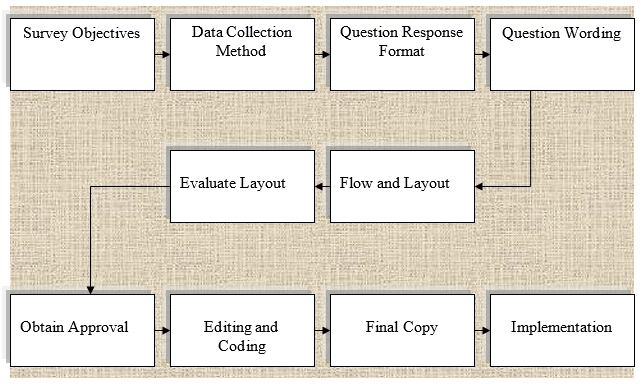
Here, it is significant to point out that both target respondent groups would have to complete section A of the questionnaire. However, employees and management of Zara would complete section A and section B; on the other hands, and the Customers of Zara would fill up both Section A and Section C. Therefore, it is clear that customers would not complete section B and employees of Zara would not go final section as different section designed for different target groups for the convenience of the researcher to analyze the survey data. However, the following table would provide more details about the questionnaire –
Table 2: – Content of the questionnaire. Source: – Self generated.
The questionnaire is included in Appendix A of this dissertation. However, the researcher has dealt with such topic, which has similarity with previous researches on customer relationship management though there are few case studies on Zara’s brand awareness and brand loyalty that can stimulate customer involvement. Most of the cases, the researchers tried to find out new thinks considering previous results; therefore, questionnaires are not matched with one another though these have some similarities.
For instance, Azevedo & Pessoa (2005) has researched with twenty-nine company to identify the influence of brand personality on advertising response in clothing industry; so, the questionnaire concentrates on the expected brand personality, brand personality dimension scores, descriptive statistics of self-concept and brand personality, congruency scores, Pearson correlation coefficients between self-congruency and advertising response measures, brand equity indicator, and so on.
Data Collection process
Following the organization of the questionnaire, it is essential to choose an appropriate data collection process by evaluating the costs and benefits of numerous data collection methods. However, because of inadequate time and more convenient medium, data has collected by using more instantaneous method, as the researcher wanted to avoid the hazard and the risks of potential bias that arises from face to face interview. Therefore, electronic mail has widely used in the process and following figure shows other instantaneous methods –

Data analysis method
Analysis is critical examination of the assemble data as data leads to generalization, which involves drawing some conclusion about a whole group or category of things based on information drawn from particular instances or examples.
At the initial stage of data analysis, the author of this paper will recheck the collected data with the aim to eliminate unintentional mistakes to formulate the findings chapter. Afterward, the researcher of this dissertation would scrutinize the survey forms because some customers and employees of Zara may not complete the survey forms or may complete all questions though the researchers designed different questions for different groups.
The researcher of this dissertation has analyzed the primary data in the light of research questions and objectives along with graphical presentation (in the form of charts, and diagrams) and description; however, it was important stage to classify data to remove errors. However, after editing, and coding the survey forms, data would analyze and graphically represent in the finding chapter and it would use excel software.
Limitations of the data collection
The researcher of this dissertation had faced many problems to collect primary data and select useful secondary data, for example –
- This dissertation consider the employees and management of Zara to interview as they easily can understand the impact of brand awareness and brand loyalty on customers as well as on the profitability of the company. However, top-level management of Zara were reluctant to cooperate due to insufficient time at hand to complete the questionnaire for the research, which was one of the most common problems of primary data collection;
- At the same time, the employees of Zara were not interested to disclose the actual influence of brand awareness on the company, as they would like to say design, competitive price, and quality of the products are the key elements of success. Consequently, the actual position of Zara after conducting IMC campaign many not properly observed because they avoid to tick few questions or provide multiple response;
- However, short deadline, word volume, and limited budget to complete the survey was another barrier;
- Moreover, it was difficult to find out resourceful and useful information as there are numerous available secondary resources in this topic but not all papers are extraordinary.
Findings and Results
The key initiative of the findings chapter is to inspect the results of the actual survey carried out to assess that how can brand awareness and brand loyalty stimulate customer involvement of fashion retailer Zara. In order to do so, the researcher had carried out a survey between two separate groups of respondents, that is, between the employees and management of fashion retailer Zara and the respective customer groups of this global player.
It is crucial to assert that the researcher had circulated the questionnaire originally to 125 interviewees, out of which the responses are given by 100 people. The rest 25 interviewees were either unwilling to cooperate or busy with their every day works to fill up the survey questions. It is important to note that among 125 interviewees, the researcher handed over 90 forms to the customer groups of fashion retailer Zara, who are either Zara’s loyal customers regularly visiting Zara’s stores or impulse purchasers visiting the stores often.
The researcher was able to do this by collecting the phone number, e- mail address, and residential address of the customers and distributing the questionnaire to those customers by different mediums. However, it is arguable that only 75 feedbacks have sent back to the researcher. The rest 15 customers showed lack of interest to fill up the forms as they had very little time to manage because of their busy life style.
On the other hand, as the researcher intended the interview two separate groups of respondents, the questionnaire had also provided to employees and management of Zara. Amongst a sum of 35 forms delivered to the employees and management, only 25 of them were able to send back the completed forms. It is imperative to note that 10 forms were left unfilled by these people. Therefore, even after supplying the questionnaires to 125 respondents (with 90 forms to the customers and 35 forms to employees and management), only 100 questionnaires have received back by the researcher (75 forms from customers and 25 forms from employees and management).
Section A: Information About the Respondents
Question 1: – Name, Phone Number, Present Address of the Respondents
It was a general question, which was indispensable to carry out a brief introduction with the respondents of the survey.
Question 2: – The Age Group of the Interviewees
This general question has asked to the respondents with the intention to know the age of the people who have participated in the survey. A better knowledge about the age of the respondents will help the researcher to find out the most reliable feedbacks in order to construct the prospective results; because older people tends to have more experience than the others, and while considering the response of the employees and management of Zara, this remains a important factors.
Moreover, this would also help the researcher to find out the viewpoints and the way of thinking of customers aging from 16 to 35 in order to conclude how they feel about fashion retailer Zara. The survey has indicated that about 36 percent people ages from 16 to 20, 23 percent ages from 21 to 25, 12 percent ages from 26 to 30, 16 percent from 30 to 35, whilst the rest 13 percent people ages above 35.
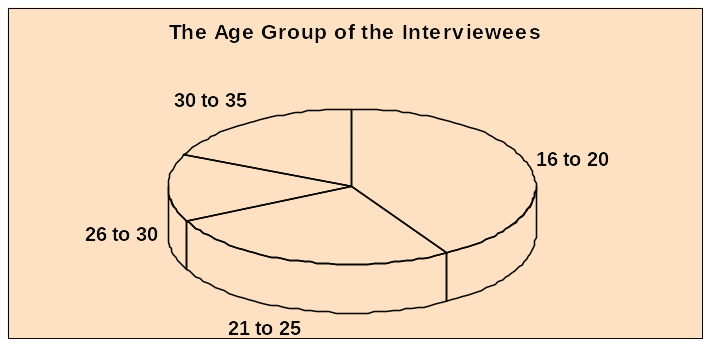
Question 3: – Profession of the Interviewees
Finding out the about the profession of the respondents is imperative in the appraisal procedure of the results as it assists to discover the trend about what group of customers are mainly the regular patrons of Zara. It is essential to state that 25 percent of the respondents are workers of Zara, whilst the rest 75 percent are in fact the company’s customers. It is arguable that the survey has suggested that amongst these 75 percent customers, 35 percent are students, 20 percent are service holders, and 10 percent are businesspersons, whilst the rest 10 percent are unemployed.
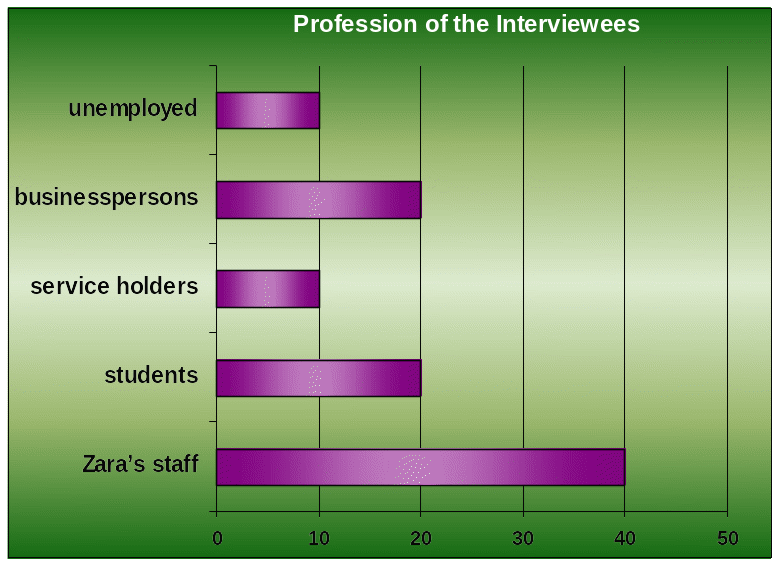
Question 4: – Whether the Respondents like to Purchase Zara’s product
There has been a range of responses to this question. Many customers showed their extreme likings in favour of the company; whilst others told that, they love Zara’s products even though there are some problems with their service. A substantial amount of respondents was also been there who expressed strong dislike against the business. However, the employees and the management of the company went on to argue that they just love the products that their company offers. This was mainly because of the fact that they are a part of Zara. It has noticed that about 76 percent people argued yes, whereas 24 percent people said no.

Section B: Findings and Results from the Survey on the Employees and Management of Zara
Question 1: – Whether the respondents think that Integrated Marketing Communications program help to develop brand image
It is now widely accepted that Integrated Marketing Communication programs or IMC helps to develop brand image of a company by attracting customers towards its products by means of extremely smart use of advertising tools and promotional components.
This question has frequently asked to the interviewees (that is the employees and management of Zara) in order to assess the extent to which the company is eager to conduct such marketing campaigns through which it can greatly enhance its brand awareness and image amongst the target group. As per the conducted survey, about 68 percent of the respondents think that Integrated Marketing Communications program help to develop brand image. However, about 28 percent have disagreed to this point, whilst the rest 4 percent refused to comment anything on this.
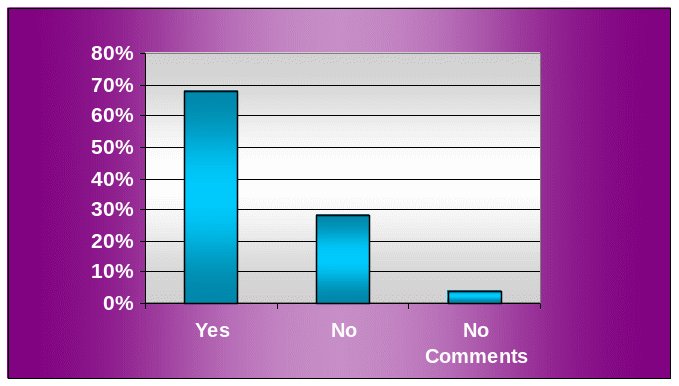
Result: – The result shows that the largest part of the respondents believe IMC to help develop brand image
Question 2: – Whether the respondents think that Zara Should Concentrate More on IMC Campaign to Aware Customers
This question has kept forward to the respondents with the aim to recognize the type of motivation of the employees and management of Zara to find out whether they think that Zara should concentrate more on IMC campaign to aware customers or whether the management have any intention to carry out IMC campaigns in near future. A superior understanding about the company’s strategy will assist the research work by discovering the extent to which the business is likely to undertake IMC campaigns. It is important to argue that amongst 25 respondents, about 56 percent of the employees believe that Zara should concentrate more on IMC campaign to aware customers, whereas 28 percent disagreed to this and 16 percent have not commented anything on the matter.

Result: – The result shows that the largest part of the respondents think that Zara should concentrate more on IMC campaign to aware customers.
Question 3: – Whether the respondents think that IMC and Other Marketing, Initiatives Have Direct Connection with Profitability of Zara
It is important to argue that the senior staffs of Zara has largely agreed to the statement that IMC and other marketing initiatives have direct connection with profitability of Zara, where as some other junior staff argued that they do not see any direct connection of IMC and other marketing initiatives with the profitability of the company. It is notable that successful IMC campaigns and marketing initiatives are highly likely to stimulate customers’ involvements with the brand and thus persuade them to buy the company’s products more often.
This, in turn, would increase the sales of the company, thus raising its profitability. Amongst the respondents, a significant proportion of employees were also present who wanted to ignore how and in what ways the company’s profitability increases. About 44 percent of the respondents argued that IMC and other marketing initiatives have direct connection with profitability of Zara, where as 24 percent argues against the statement. On the other hand, about 32 percent people have not commented anything on this.
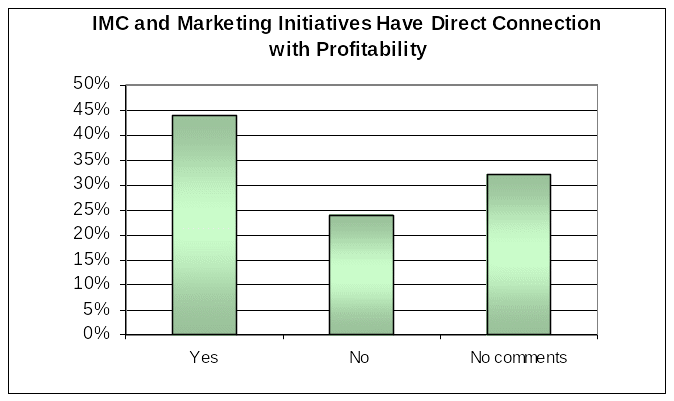
Result: – It has noticed that the major percentage of the respondents has commented yes on the survey page.
Question 4: – Whether the Respondents Provide Update News to the Customers Regularly
The researcher put forward this question to the employees and the management of Zara with the aim to know about the quality of service that the company provides to its customers. Through the feedbacks received from this question, the researcher will be able to work out the extent to which this fashion retailer is able to provide high quality service to the customer and whether the customers are happy with the services in turn.
However, chances are there that the respondent, because of being a part of the company, have provided feedbacks, which are potentially biased towards their company. About 48 percent of the respondents have agreed to the point, 16 percent have disagreed, whilst the rest 36 percent have not commented anything.

Result: – It has noticed that being working at Zara, a large portion of the interviewees has agreed to the statement.
Question 5: – Whether the respondents think that Zara Should Ask Reasonable Price to Attract More Customers
This question has frequently asked to the interviewees in order to assess the extent to which they agree that the company’s pricing strategy is not correct currently because of the fact that the prices of the products are not suitable for those who are students or unemployed. Because of the fact that the respondents in this segment are employed at Zara, the majority of the population has observed to ague that the company asks reasonable prices to the customers.
However, many agreed that asking reasonable prices is one of the most significant ways to attract the customers. About 36 percent of the respondent agreed that Zara should ask reasonable prices in order to attract the customers more. However, about 32 percent disagreed to this and the rest 32 percent have not commented anything on this issue.

Result: – The figure illustrates a mixed reaction has received from the respondents.
Question 6: – Whether the Respondents Think that Customer Feel Comfortable in Asking for Services from Zara
This unusual question has kept forward to the respondents with intent to distinguish whether the company and its staff are enough confident about the service that they provide to the customers and about the question that whether the staff at the customer service are so humble with them that they feel comfortable to ask for service at anytime they want. About 68 percent people argued that they agree with this statement, whereas about 20 percent disagreed to this statement. However, just 12 percent showed their disapproval to comment about the matter.
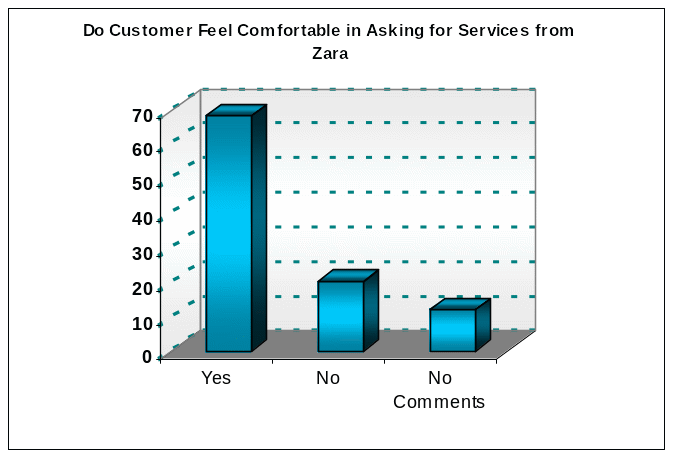
Result: – The result illustrates that the principal portion of the respondents said yes to the question.
Question 7: – Whether the Respondents Think that Zara Should Use All Media of Communications to Increase Customer Involvement
Today, it is widely accepted that the use of all forms of media of communications help to increase customer involvement. In case of Zara, the company is not current using this strategy. However, at the survey, about 44 percent pf the respondents agreed that use of all forms of media of communications help to increase customer involvement. Conversely, about 24 percent have disagreed to this and the rest 32 percent have not argued anything.
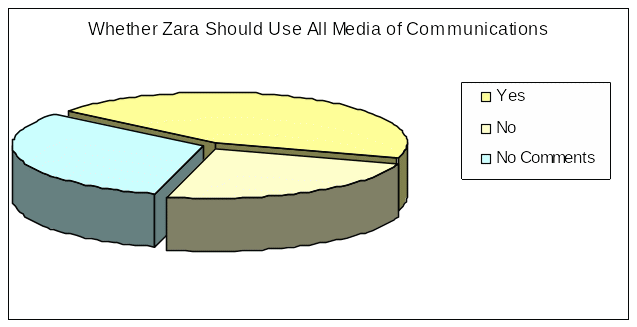
Result: – Many people agreed that this is a good way to enhance customer involvement.
Question 8: – Whether the Respondents Think that Think Zara’s Strategy Is Better Than The Competitors’ Strategies To Attract More Customers
About 56 percent of the interviewees suggested that Zara’s strategy is better than the competitors’ strategies to attract more customers, whilst about 16 percent said no. Moreover, about 28 percent said no comments.

Result: – The result indicates the fact that a good percentage of the respondents believe their company’s strategies to be the best.
Question 9: – Whether the Respondents Think that Zara Should Use Latest Software to Maintain Relationship with Customers
In answering to this question, 92 percent interviewees agreed that Zara should use latest software to maintain relationship with customers, whereas merely 8 percent argued no. However, none of these people has agued no comments.

Result: – it is widely accepted that the use of software is extremely crucial.
Section C: Findings and Results from the Survey on Customers of Zara
Question 1: – From Where Do the Respondents Gather Knowledge about Zara
Amongst 75 interviewees, about 26.66667 percent people gathered knowledge about the company from website, 40 percent gathered knowledge from stores, 24 percent from advertising, and about 9.333333 percent from other sources.

Result: – The result shows the fact that most people gathered knowledge from stores.
Question 2: – Why Do the Respondents Like To Use Zara’s Product
About 34.6666667 percent people like to use Zara’s product because of design, 37.3333333 percent because of marketing performance, 13.3333333 percent because of brand image, 9.33333333 percent because of price, and about 5.333333 percent because of other reasons.
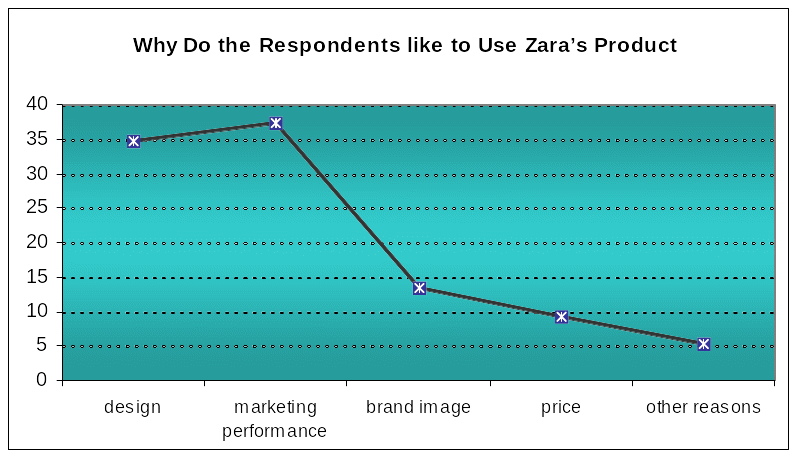
Result: – The respondents specially pointed out the importance of design and marketing performance of a brand.
Question 3: – Whether the Respondents Think that Zara Offer Unique Design
The feedbacks received from this question have been a mix reaction from the side of the respondents. About 52 percent people think that Zara offer unique design, whilst 30.666667 percent disagreed to this and about 17.3333333 percent said no comments.
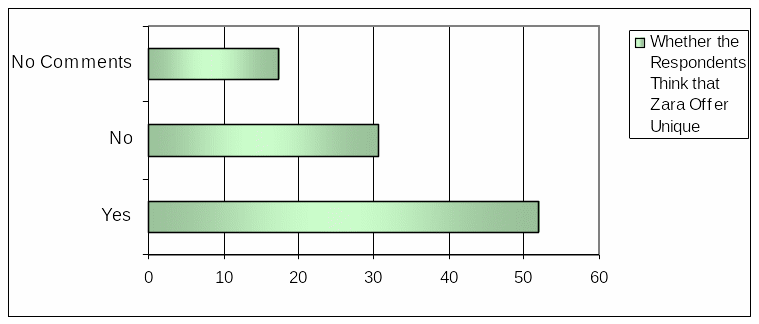
Result: – In majority of cases, people think that Zara offer unique design.
Question 4: – Whether the Respondents Think that Zara Should Provide Quicker Service for Certain Products
Approximately 56 percent people think that Zara should provide quicker service for some products, whilst 28 percent disagreed to this and about 16 percent said no comments.

Result: – It has clearly noted that in most of the circumstances, the people think that Zara should provide quicker service for some products like woollen clothes and sweater. Many of them commented that in certain cases, during winter, after ordering a certain type of sweater at extreme cold, Zara delivered it long after winter had gone.
Question 5: – Whether the Respondents Think that Zara Should Develop Communication with Customers
About 54.6666667 percent people think that Zara should develop communication with customers, whilst 30.66666667 percent disagreed to this and about 14.66666667 percent said no comments.
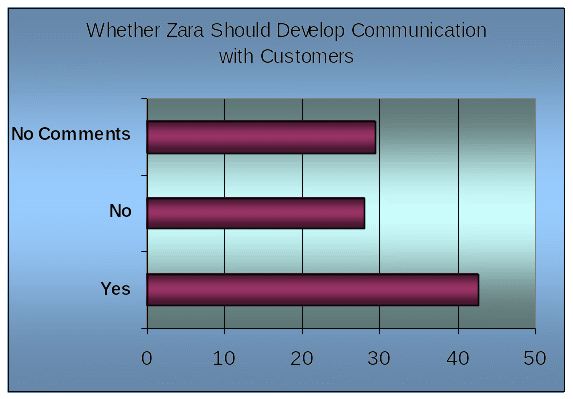
Result: – It is arguable that most people think that Zara should develop communication with customers.
Question 6: – Whether the Respondents Again Think To Purchase Zara’s Product
Approximately 42.66666667 percent people think to purchase Zara’s product again, whilst 28 percent disagreed to this and about 29.333333333 percent said no comments.
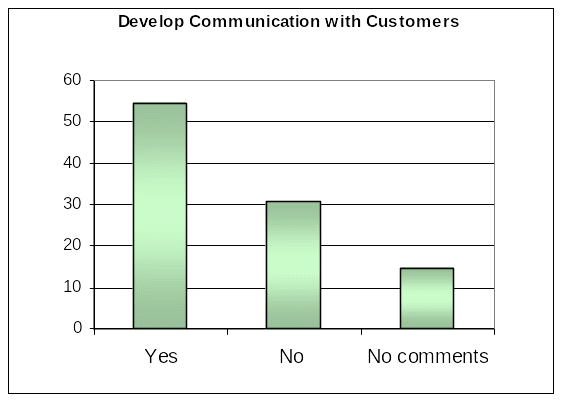
Result: – Many people think to repurchase Zara’s products.
Question 7: – Whether the Respondents Would Recommend Zara’s Product to Others
About 44 percent people would recommend Zara’s product to others, whilst 29.333333 percent disagreed to this and about 26.66666667 percent said no comments.

Result: – The figure above shows that the numerous interviewees want to recommend Zara’s product to others.
Summary of Results and the Potential Links with Key Points of Chapter 2
It is essentially noteworthy that the key results received from the conducted survey on Zara have revealed major similarities with the academic theories discussed in the literature review previously. In response to some questions, the largest part of the respondents believed that IMC campaign should to help develop brand image; therefore, Zara should concentrate more on IMC campaign to aware customers.
This idea has also supported by renowned authors like Bian and Moutinho (2009), Bowden (2009), Brakus, Schmitt, and Zarantonello (2009), Casalo, Flavian and Guinaliu (2008), and Cavero and Cebollada (1997) in their respective articles as suggested in Chapter 2. Moreover, in response to the question of whether the respondents think that Zara should use latest software to maintain relationship with customers, it was widely accepted that the use of software is extremely crucial; Guthrie and Hye-Shin (2009), Herbig and Milewicz (1993), and Sahay and Sharma (2010) has emphasized on the use of contemporary methods to boost relationships with customers.
One of the other key results of the survey suggests that the respondents think that Zara should use all media of communications to increase customer involvement. Use of numerous media communications to amplify customer involvement has also proposed by Sugandhi (2008) and Kotler (2003). A key result of the survey has specially pointed out the importance of design and marketing performance of a brand; it is arguable that Loker and Kamali (2002) and Ohand and Loker (2002) has pointed out the significance of design and marketing performance of brands upon customer involvement in the previous literature.
Discussion
The aim of this chapter is to answer the research questions by following research objectives with theory and taking evidence from annual reports of Zara, Harvard Journal reports, CNN reports, and book on Customer Relationship Management by Sugandhi, Scholory articles on Zara by Mellenius (2008), Craig, Jones, and Nieto (2004), Palladino (2010) and so on.
However, Sharp (2000) and Chi, Yeh, and Yang (2009) have already mentioned that brand awareness influences the customers to purchase products, and this statement has also supported by the primary data, which has analysed in findings chapter. As a result, this chapter would provide practical evidence on the impact of brand image and brand loyalty, which have discussed in findings and literature review chapters; however, this chapter concentrates more on Zara Fashion as it would analyse this case.
Zara’s Marketing Strategies, Brand Awareness, Loyalty, and Customer Involvement
Through brand awareness, Zara creates familiarity of its brand by repeated exposure through the combination of brand recognition and brand recall (Keller, 2007-2008). Customer loyalty is also helpful for attracting and attaching customers with the company for long- run (Engel, Blackwell and Miniard, 1995 and Mowen and Minor, 2001). By incorporating both these concepts, Zara’s marketing division is using a number of strategies for ensuring customer involvement (Sugandhi, 2008).
The company has achieved customer attention for its well- focused approach of market- orientation as its major marketing strategy. In this regard, its marketing division is using vertical integration with shorter lead times. Regardless formal exhibition of its various garment items, Zara relies on direct marketing strategy with attractive out and in- store atmosphere (Mellenius, 2008).
Every new item designing takes only 9 months duration, which motivates customer involvement with their current preferences. Moreover, whenever customers recall the Zara brand, they must consider the company’s style of keeping each item within the shortest time cycle. It means, Zara tends to maintain mock scarcity of its items for two weeks. This tendency acts as awareness for the customers since they are influenced to purchase the item at once while visiting a Zara store as that item would be unavailable for later time. Through this technique, it can easily identify slow selling products and can drop it for further production.
The most important fact is that, like others, Zara’s marketing is not related with direct communication. Rather than, it develops and implements brand awareness by creating distinctive customer image (Mellenius, 2008). This distinctive customer image has created because Inditex’s flagship brand, Zara, has comparatively considered as more trendy than all the other 3 and charges lower than Benetton or Gap, but higher than H&M; the brand positioning map below reveals the facts about the competitors:
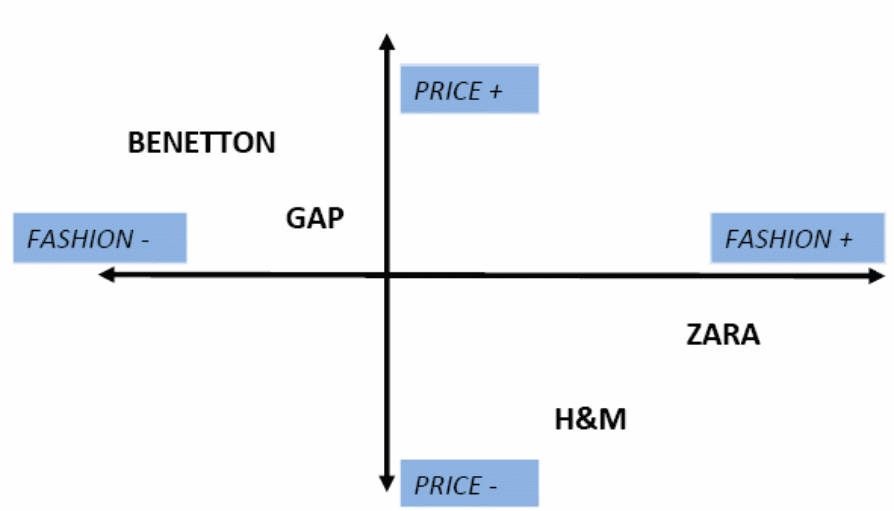
Thus, a number of factors can be considered as the attractive components of Zara, like- product freshness, scarcity idealization, attractive store environment, favourable word- of- mouth influence, inside- showroom ads, and Facebook page etc. However, Zara does not rely much on traditional form of advertisement like other homogenous brands. It pays out only approximately 0.3% of its income for ads, which is also limited within the starting and ending season of sales. It also avoids billboard advertising that is commonly practiced by most of the fashion retailers. This practice assists the company to overcome the effect of overexposure, which is also effective for developing favourable brand image and customer orientation (Craig, Jones and Nieto, 2004).
Additionally, Zara’s marketing division is continuously focusing on high- fashion with low cost brand message for developing a favourable customer recognition point. Among limited number of ads, it is arranging costly and polished campaign programs along with celebrity endorsements mostly encompassing on locations. Most of Zara stores are located at highly populated and high- end retail places among which merely 92% are owned by the company.
All those stores are decorated by bright lighting, wall photos and white coloured ceiling and walls for expressing a graceful European look. It enables Zara for having better control on branding, pricing and customer fashion- orientation. For this reason, its marketing believes the store environment as one of the strongest advertising issue of the brand (Slideshare, 2009). Moreover, better performance in this segment means stronger financial position for Zara:
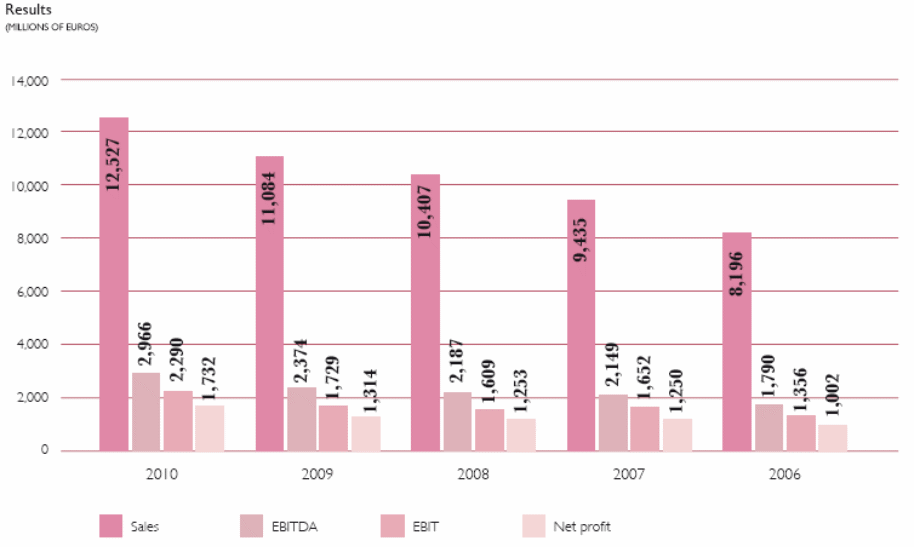
For generating more awareness, the company executes an online site known as Zara.com, which represents the brand and offered items in sophisticated way. Featured by language benefits, colourful background, pull down menus and musical empathy, this site acts as the promotional tool for the company by showing the brand message as “Get into the flow…get cool”. Such slogan informs about the superior and latest quality apparel of Zara to the visitors. Zara.com also shows cyclic virtual catalog with an option of quick download along with short message about the opening of new stores.
One of the most advantageous features of this site is it incorporates multiple links that helps the visitors to check other items or area. Clickable symbols, crisp photos thumbnail and customer service are some other features that always portrait the brand’s uniqueness with favourable image. In such ways, it uses internet for linking brand awareness with potential customer action or ultimate sales (Manning-Schaffel, 2004). Despite of these online advertisements, the revenue of the company was not able to exceed its competitors in 2008 as shown below:
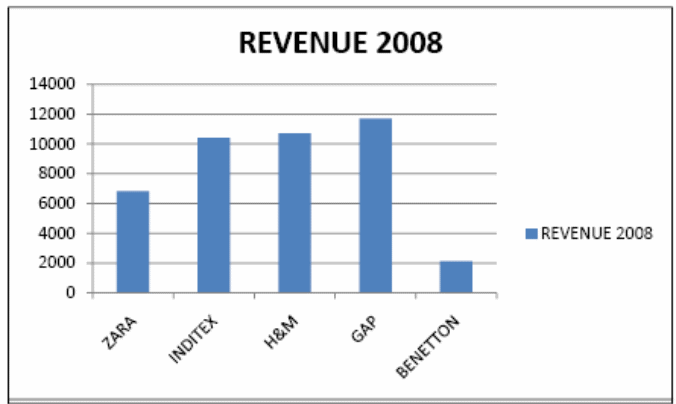
Zara also organizes various modes of marketing research as the means of brand awareness for ensuring customer involvement. Its manufacturing cycle begins by the judgment of customers regarding the cloth design followed by the gathered information from its staff. This staffs is engaged in travelling throughout fashion cities for the observation of people found at various streets, venues and publications. Customers are involved here through their direct opinion and demand for a particular design for which a potential customer takes a 17 times visit to a Zara store (CNN, 2001).
Zara has developed a sense of “instant fashions” through its low cost and fashionable apparel. It offers experiential signals of fashion items, creates symbolic communications between the offers and emotional feelings of the customers and influences them for impulse purchase by generating sufficient level of brand recognition and recall. Its marketing thought builds such symbolization of Zara products through which customers are forced to believe that this brand knows their body structure, makes them beautiful and appears them great.
It focuses on the stronger aspects of the brand regarding materials and colours as customer quality perception, differentiation bases and freshness. It also informs customers about the new items through the integration of positive public emotion, interest and buying motives towards such items. Its core value proposition is less is more as less price for generating more value and USP (Unique Selling Proposition) is “The only true fashion brand to consider your body shape”.
Additionally, different forms of communication modes are used for brand awareness that also contribute in customer involvement. For example, above- the- line ads which only incorporate print advertisement while below- the- line ads use public relation, internet, media cooperation (for example, reality shows), brand communication, online advising programs on distinguished products for distinguished body shapes and even management. It also conducts magazine advertisement with attractive presentation of products and editorial exposure (Slideshare, 2009).
Finally, Zara’s marketing division is also conscious in integrating its core objective with customer- orientation. The company’s positioning strategy focuses on exclusive design, medium quality and affordable price. For communicating such benefits, it randomly undertakes market education programs for manipulating buyers shopping behaviours that are also helpful to balance its relatively high prices and image in the global market (Temkin, 2008).
At the same time, the fashion retailer is using various loyalty drivers for having a better customer involvement with the brand. Among these drivers, customer attitude, product and service quality, technological knowledge, internal culture and human resources are major ones, which are very proficient to fulfil such objective (Sugandhi, 2008). Through these strategies, Zara was able to involve extra customers and generate additional profit, which helped it a lot to open more and more stores:
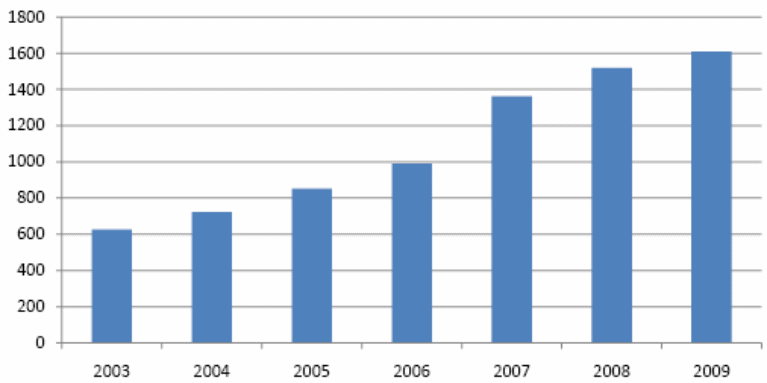
Such rising number of stores helped Zara to expand more globally, as shown below:


Customer attitude
Zara influences both the emotional and rational attitude of customers by motivating them for having a fast visit to the store at every 15 days. As a result, it can change the production process with necessary customer requirements (Temkin, 2008).
Human resources
One of the most significant competitive advantages of Zara is its employees. Those staff also acts as source of information about current fashion trends, customer choices and their feedback as cool, hot or elapsed objects from the present collection. For example, if a customer chooses one item and expresses a comment as tracked by a sales staff, it will be instantly transmitted to the managing body upon which within two weeks such item will be manufactured. This strategy also exemplifies Zara’s market response and offer variation quality (Temkin, 2008).
The shop managers of Zara regularly inform the backstage designers about the unsold items. Based on such information, it can confirm the specific colours and lines which would be sustained or changed or manufactured (CNN, 2001).
There are about 5000 logistics staffs with especial expertise, so many designers who get the opportunity to work with maximum flexibility and a total of 89112 professionals. Combining all of those personnel, Zara occupies an excellent HR team with extensive knowledge in sales that also acts as a customer- orientation device (Slideshare, 2009). Moreover, Zara continued to create more employments, for which number of employees of the Inditex Group continued to rise despite recession:

Uniform of the staff is another important factor through which Zara gains another competitive advantage from other competitors. It also helps Zara for having a material presence of the brand along with making a better conduct with customers.
Customer orientation
Zara’s marketing is highly committed to deliver customer value. For this, it undertakes the initiatives of cracking supplier- oriented paradigms for expanding level of status and practices 5 disruptive customer experience strategies (Temkin, 2007). Such as-
- Zara relies on ultra simplicity through the practice of “continuous improvement”. As a result, most of the Zara shoppers show loyalty for meeting their upcoming needs.
- Zara’s online infusion practice differentiates it from many other brick- and- mortar retailers. It also offers customers the option to have a participation in the designing and selection process.
- This brand is also unique in delivering relevant service infusion.
- It not only delivers any simple service but also makes amplifications according to the necessity.
- Zara tries to have close customer target for which it is continuously practicing value proposition strategy.
Because of such customer orientation, Zara’s revenues continued to grow gradually:
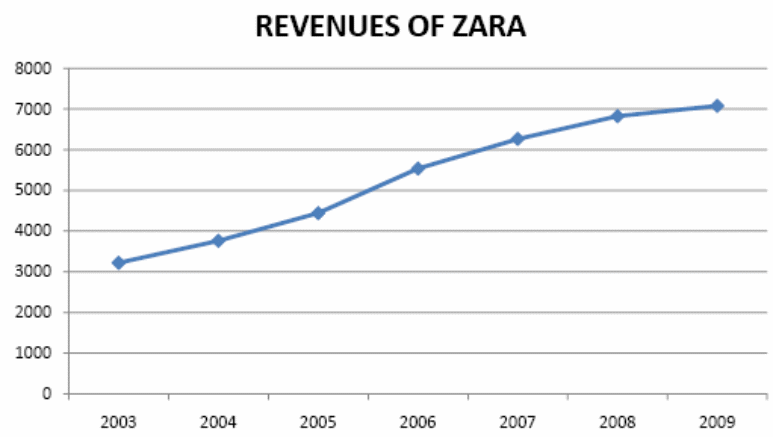
Product/ service specialty
Zara delivers multiple fashion items for the same customer segment, especially, for the women regarding fashion content, prices and age. In this manner, loyalty between the brand and the customer group tends to increase. After having an entrance into a Zara store, a customer is automatically and emotionally attached with the brand by observing its beautiful, exceptional, affordable prices and high quality products.
Apart from this, its capacity to reduce cycle time for the introduction of a new item makes it more responsive to the changed customer needs in sophisticated ways. As a result, customers return to Zara again and again for verifying the latest fashions (Baykal, 2011).
Customer analysis
Zara’s marketing encompasses on market research as an important loyalty measurement tool. As a part of such findings, it explores that most of its current customers are highly fashion concerned, educated, choosy, demanding and savvy. So, it tends to draw more public interest by delivering pleasure and enjoyment through their offerings. It also inclines customers to put their self- expression and emotion for brand involvement. Analysis of personal motives also assists marketing to understand the projected self- image of its brand (Slideshare, 2009).
Fast fashion image
The brand is well- known with its fast fashion image as the customers are acknowledged about the perfect timing within which a new item would be displayed in a local store. It creates an ultimate hurry among them for which most of the loyal customers of Zara feels the necessity for having a fast visit to the Zara store. Moreover, customers also get an opportunity to directly input into the brand’s sales statistics because of the fast transformation of their feedback to the designers. For this reason, it is also called a brand of “democratization of fashion” (CNN, 2001).
Internal culture
Zara has developed a brand image through which customers are also aware about its internal pleasant atmosphere. Its brand loyalty is based on distinguished quality, uniqueness and sleek designed apparel that attracts new and satisfied customers for impulse and repeat purchase (Deighton, Henderson, and Neslin (1994); Sahay and Sharma (2010) and Chaudhuri (1995). Thus, it utilizes internal retail environment for positively affecting customer purchase intentions through good- looking layouts, advanced sales team and other components (Slideshare, 2009).
Since Zara maintains a culture of fast changes, customers have the options of either visiting the store or going to the web site. If they feel that neither to choose nor to purchase right now, they become assure that something new will be coming soon within next day or next week and thus have a wait with interest for getting such new offer. In this manner, Zara creates a self- opportunity for having another visit by the customers (Tiplady, 2006).
Technology
Zara’s communication and information technology plays a major role in building loyalty. It uses human intelligence and IT for the purpose of building a hybrid informational structure for sending customer feedback, their demand and other relevant information from sales centres to headquarters. More than this, its sophisticated technological background supports inventory management, supply- demand equilibrium and market responsiveness. By all those ways, Zara becomes effective in creating customer integration through brand loyalty (Zara, 2010).
At this stage of the paper, it is essential to recall a very important opinion of Aaker (1991) that was agreed upon in the literature review section after justifying why the statement is important, and why it is necessary to agree with it. According to Aaker (1991), whilst customers choose a product, they care about apparent quality and brand awareness – apparent quality could assist customers to have a one-sided decision on general product quality that make the item grasp an outstanding uniqueness and turn itself into a choosy brand in customers’ hearts; besides, firms have to build up brand loyalty.
This indicates that the author emphasized on the importance of product quality, and that it is not just enough to concentrate on conducting brand awareness programmes to create an exceptionally exclusive and differentiated brand. In enhancing the brand image, the product quality plays an important role to ensure customer’s involvement. As shown in the brand-positioning map of Zara in figure 22, its products are highly differentiated in terms of fashion and quality.
Therefore, in creating brand awareness, Zara not just focused on branding programmes or advertisement, but also focused on quality. This, as stated by Aaker (1991) has played a great role in branding Zara successfully. The rising number of stores of Zara in figure 25, its global expansion of 2003 in figure 26, global expansion of 2009 in figure 27, and increasing revenues in figure 29 indicates the success of its strategy of focusing on product quality.
Suggested Probable Strategic Alternatives for Zara
Alternative 1: Developing IMC Campaign
The marketing executives of Zara should focus on developing IMC campaigns, which could increase its customer’s involvement:
Alternative 2: Reformation of the Pricing Strategy
Apart from of the marketing efforts, customer involvement can further enhance through a proper pricing strategy:
Best Practices in Improving Customers’ Perceptions towards More Involvement
For improving customers’ perceptions towards more involvement, it is very necessary to build adequate level of brand awareness and customer loyalty. In this regard, each firm under the industry should attempt to confirm that the target customers are aware about the values of their delivered offerings. Therefore, most of the successful brands in fashion and apparel industry tend to express their superiority over competitors to the customers. The purpose of such activity is to broaden the perception of buyers in terms of enhancing the level of their awareness and loyalty level to the brands (Recklies, 2006).
Marketing practices
Creation and expansion of brand awareness is the first and foremost strategy practiced by most of the brands in fashion and apparel industry. A large number of traditional marketing tools are used for generating such awareness regarding advertisement, publicity and public relation, personal selling and sales promotion. Multi- channel marketing also involves promotion through web sites, catalogs and e- buys. Such patterns of marketing attract the attention of customers by offering the exclusive opportunity of faster product search, comparative information on 4P’s (Product, Price, Place and Promotion) and present and extra services to the marketers etc. Companies also track customer choices by using those modern forms of promotional tools (Oh and Loker, 2002).
Product and price
For gaining highest level of public awareness, this industry concentrates on differentiation and competitive advantage. By producing superior quality products and delivering them at comparatively cheaper rates, some world- class- brands have become able to gain that advantage. Brands, like- Zara and Mango are now offering their customers this combination, which is contributing greatly in enhancing customer traffic in their stores continuously (Tiplady, 2006).
Location advantage
Presence of location advantage is prominent for having huge customer traffic. For this, the industry implies the need of establishing multiple stores of various brands at suitable location. Thus, multiple stores are located at central places of the cities and commercial areas so that people can easily access to the stores and face no complexities for further visit (Recklies, 2006).
Flexible distribution
Distribution or supply chain also contributes greatly for increasing customer loyalty followed by their involvement. Reduction of cycle time in production and marketing delivery diminishes customer-waiting time for getting an offer, which makes them delighted about the brand’s distribution approach (Temkin, 2008).
Advertising and media exposure
Advertising is the foremost strategy used by most of the giant industry partners. Mango and Topshop are two companies, which spend huge amount of money for advertisement purpose although Zara is quite different in this case since it spends a very little volume of its budget for this purpose. The industry is highly concerned for exposing ads on various fashion magazines. Damernas, Elle and Glamour etc. are some famous world- class fashion magazines chosen by internationally recognized fashion brands to show their brand profiles and new items. Some brands also publish articles and newspapers to pull the attention of fashion- conscious customers (Mellenius, 2008). The form and volume of media exposure trends of giant brands are explained as following-
- Topshop occupies the largest share of media attention followed by Benetton, Mango and Zara.
- Different forms of exposures generally entail three categories regarding photo shoots with model, what to purchase and others. Under the first category, selected picture is exposed throughout a single page. This is strategy is said to be most attractive since it is able to quickly gain customer’s attention. Marketers basically don’t have any control under the second category since this kind of advertisement depends on the preference of editorial staff. Here, different articles and columns are written on brands and their offerings. Finally, the third category incorporates simple and narrative information about the brands and products.
Integrated marketing communication
It is another common practice of the industry to use integrated promotional tools under the AATAR (Attributes, Awareness, Trial, Availability and Repeat) principle. Since arrangement of promotional programs is not sufficient to sustain over success empowered by brand awareness and loyalty, some companies have regular monitoring programs for achieving long- run customer involvement.
At the same time, threshold level of such effort is also changed by region-to-region and segment to segment based on the necessity, culture, customer demand and channel. Thus, the level of customer loyalty highly depends on favourable brand image, competitive advantage and customer responsiveness, which perform as the major linkage module between customers’ positive involvement and the brand (Baykal, 2011).
Store decoration
In- store decoration acts as another strategy for attracting customers. Successful brands, like- Mango or Zara maintain a comfortable store atmosphere to provide the customers a sense of pleasure. Most of their store locations are placed in prime areas, either at mid- cities or popular shopping malls through which they are able to implement place advantage for having more customer crowd. Stores have adequate shelf- space, decorated by lights, photographs and other elements of attractive interior designing and the latest collection of apparels as well as fashion items. This pattern of pleasant store environment acts as awareness point for the customers and alerts them to visit more and have a purchase (Mellenius, 2008).
Segmented promotion
Providing the fashion customers various financial and non- financial services involving referrals, credit incentives and in- store rebates and premiums are popular practices of the industry. For example, some well- recognized brands go for age- oriented promotion. Under this program, they incorporate celebrity endorsement, event management and contest and sweepstakes in order to increase young generation’s perception for the involvement with their brands (Mellenius, 2008).
Customization
Customization is one of the most updated and progressive approach to increase customer involvement in this industry. Customization generally involves matching the fabric, colour, shape, style, fabric, ordering and design to the unique needs of the customers. Technology plays a significant role in delivering that level of customization. For example, CAD (Computer Aided Design) pattern design, product designing and fabrication planning are frequently used by many brands.
There is also an intensive use of IT for sophisticating the promotional effort in terms of delivering customer demand, response and feedback over the information channel from sales centres to management. Zara is frequently using this technique, as the brand is well- known for its fast transformational capacity of information (Oh and Loker, 2002).
Furthermore, there are six steps of involving customers under the mass customization process for gaining competitive advantage in the apparel and fashion industry (Loker and Kamali, 2002). The steps are-
Table 3: Model of apparel mass customization. Source: Loker and Kamali (2002).
Here, models or designs are selected on the needs and requirements of a customer through the use of CAD before the real purchase of an item. Then forecasting indicates understanding the future demand of a customer or a particular customer segment. Next, supply of a finished order involves POS or shop delivered data. Finally, post purchase customization indicates customer’s ability to adjust with the sold item upon which loyalty level and repeat purchase intention of the customer are dependent (Loker and Kamali, 2002).
Now- a- days, customization through internet is getting more effective for the increasing customers’ perception towards involvement. Customized websites give customers such opportunity through which they can communicate their demands and requirements to the brands. It also enables them for participating in the product-designing curriculum. Additionally, voting and delivering feedback or commenting on designs through the site is also possible.
In this regard, some famous brands have association with social networks involving MySpace, Facebook, Flicker and Twitter etc. Some also use other e- marketing or social networks as blogs, e- mail marketing or newsletters. By such types of community integration, various brands can inform the potential buyers about their current offers and thus create enthusiasm for visiting their stores.
Customers are also able to share their innovative ideas or their addition for a particular design in the online spaces as given by the brands. As a result, creative designers realize public preference and put their labour to design such items as directed or required by the customers. Based on corporate satisfaction level, customers tend to contribute their pleasure among peers, expand reach and divert other possible online customers towards the brand. In this process, both brands and customers share their inherent talent for meeting own objectives of building loyalty with co- interaction (Drummond, 2010).
Customer responsiveness
Since it is very important to quickly response to the market demand, the industry is getting more and more focused with customer responsiveness approach. Under this process, brands practice to immediately understand customer demand along with current and forthcoming changes in style. On the basis of such information, they develop and restructure their designing and production process and offer the manufactured items as soon as possible to the market for quickly capturing customer value and establishing a long- term relationship with them (Craig, Jones, Nieto, 2004).
Viral marketing
The industry also uses internet as a medium of generating and expanding awareness through the process known as viral marketing. Because of the widespread use of those social networks, customers themselves occupy the power to impact the buying attitude and preference of one another through their word- of- mouth influence about a brand. Generally, it is said that one satisfied customer can create another satisfied one but a single dissatisfied customer could undo the effect of three satisfied customer. Especially, in fashion and apparel industry, the influence of such variable is greater for which brands are also highly conscious in creating favourable word- of- mouth image for assuring more customer involvement (Zara, 2010).
Favourable image
Image differentiation is very necessary in the fashion and apparel industry since it the prime factor for the customers for entailing trust and establishing relationship. Different brands have developed different images in the minds of customers upon which they are showing different appeals and buying attitudes. However, this strategy incorporates building a fast, fashionable and customer- orientated image through which customers are inclined to provide their cordial involvement with the brand (Baykal, 2011).
Forecasting mechanism
Forecasting of future style is another strategy, which is frequently used by many brands for enhancing the loyalty base of their customers. In this strategy, brands provide various kinds of customer- oriented fashionable tools. It helps them both in delivering the customers time- oriented information and in reducing the costs caused by forecasting mistakes. For example, the famous brand StyleHop first introduced the strategy of using perfectly measuring customer choice and style- intensive forecasting risk tool.
It also ensures simple IT introduction, uploading or downloading facilities to their customers. As a result, majority of their customers feel happy and relax to have such easy and speedy online service along with scaring the complexity for the development and management of personal website. Therefore, this strategy is said to be effective for having an association of fashion conscious customers of 21st century (Drummond, 2010).
Broader IT support
In today’s fast and changing environment, implementation, and integration of IT becomes very important for various industry partners. Therefore, the industry is highly enthusiastic for having adequate level of IT support for both communication and service purpose. Brands regarding Zara follow this technique in order to provide the customers easy access to its web site with smooth co- ordination in product designing, modification or other suggestions (Zara, 2010).
Sophisticated HR
Skilled and trained human resource is another component through which the industry is increasing customer perception for better involvement. Employees of many repudiated brands are contributing in achieving such goal through their behaviour, co-operation, and communicative power. They act as the medium of exchanging information between customers and brands, deliver feedback on behalf of customers, and also influence in the purchasing process. Uniform, gesture, posture, facial expression, behavioural norms, product knowledge of the staff can directly or indirectly instruct people whether to have a repeat visit or not.
Conclusion
Recommendations
- Throughout its history of operation, Zara have not emphasized greatly on creating brand awareness and brand loyalty through campaigning and advertising through television media. In the findings chapter, most of the respondents identified that IMC-campaign should help develop brand-image; therefore, Zara should concentrate more on interactive and TV advertising to increase awareness; this concept has also focused by Bian and Moutinho (2009) and Cavero and Cebollada (1997); Sugandhi (2008) and Kotler (2003) also suggested the use all mediums of communications to increase customer-involvement significantly. It is important to argue that for a industry like fashion apparel, where the main consumers are young population of the market, it is hugely necessary to carry out promotional activities through a media that can attract mass population at the same time by means of extremely well presented marketing gimmicks. This advertisement and promotional activities, if properly well researched to suit the psychology and behaviour of the customer group of ages between 16 to 35, can greatly influence these concerned groups but catching their attention completely and awaking them about the brand and thus enhancing the brand image. As a resultant effect, it can notice that these customer groups are getting more and more involved with the brand because of the brand image it possess. In addition to this, as because the teenagers spend a great deal of time in watching TV, the success rate of this advertising toolkits could be huge.
- Another important factor through which the company can adopt in order to increase its brand image is to carry out massive investments in celebrity endorsements. By creating highly creative and eye catchy celebrity endorsements after long and in-depth research from the marketing department of Zara, it would be possible for the business to build an awesome relationship with the customers. It is essential to note that these celebrity endorsements will cause the brand to be differentiated from competitors like H&M and engage customers more towards Zara because consumers not buy brand and enjoy the consumption of the product, they consume the “imaginary differentiation” that goes with it – this imaginary differentiation would construct only when celebrity endorsements have conducted accurately. This concept has supported by Doyle (1990) in Chapter 2.
- The call centre of Zara needs to be virtual and dynamic to respond to the demand and enquiry of the customers, as there are few dilemma in CRM issues;
- It should take technological advantages, such as implementation of Microsoft [Dynamics] CRM to increase sales by supporting sales team;
- In effort to strengthen the brand image and engagement with the customer further, it is crucial for the business to undertake more investments in online marketing. This is mainly because of two reasons. Firstly, it is now the cheapest and the most convenient form of advertising media, which means that the marketing costs of the business will greatly reduce, lowering the production cost, and thus lowering the selling prices of the product. By selling at lower prices, the business will be able to involve more and more consumers. Secondly, in this era of globalization, when Zara need to operate all across the global, and almost every form of media has geographical restrictions (for example all national TV channels are not broadcasted at all the countries across the world), online advertising medium is the only way through which the company is ably to touch billions of youngsters worldwide. Most importantly, Herbig and Milewicz (1993) and Sahay and Sharma (2010) has emphasized on the use of modern techniques to improve relationships with customers. Therefore, although Zara is currently marketing over the internet, these efforts should come about in a further well-researched and organized way.
Conclusion
The research questions have addressed mainly in chapter five “Discussion” of this dissertation considering the research objectives also; moreover, Chapter 4 “Findings and results” particularly concentrates on the aims of the research and final chapter covers all issues other chapters focus on research topic, objectives, questions and so on. However, Zara, one of the most renowned fashion retailers global, has undertaken countless brand awareness building marketing strategies throughout its history of operation.
Whilst some had been successful, other was not. For many Europeans, Zara is a recognizable face with always fashionable and new apparel every week; whilst for Americans, Zara is just getting its feet wet in the American marketplace, so Inditex should research and develop new techniques for involving more customers in order to stay innovative in the clothing industry.
However, in this ever-changing world of competitive rivalry, it is important for the business to undertake continuously extremely creative brand differentiation and image building programs to lead the industry with huge market share. Therefore, generating customer involvement through advertising campaigns would remain as the central focus for the company.
Appendix A
Questionnaire
Section A: (About respondent)
- Your name: _____________________________
- Your Phone number: ______________________
- Present Address: _________________________
- Please select you age (years) group:
- 16-20
- 21-25
- 26-30
- 30-35
- +35
- Please select your profession:
- Student
- Service
- Business
- Unemployed
- Do you like to purchase Zara’s product?
- Yes
- No
Section B: (For employees and management)
- Do you think Integrated Marketing Communications program help to develop brand image?
- Yes
- No
- No Comments
- Do you think Zara should concentrate more on IMC campaign to aware customers?
- Yes
- No
- No Comments
- Do you think IMC and other marketing initiatives have direct connection with profitability of Zara?
- Yes
- No
- No Comments
- Do you provide update news to the customers regularly?
- Yes
- No
- No Comments
- Do you think Zara should ask reasonable price to attract more customers?
- Yes
- No
- No Comments
- Do your customer feel comfortable in asking for services from Zara?
- Yes
- No
- No Comments
- Zara should use all media of communications to increase customer involvement?
- Yes
- No
- No Comments
- Do you think Zara’s strategy is better than the competitors’ strategies to attract more customers?
- Yes
- No
- No Comments
- Do you think Zara should use latest software to maintain relationship with customers?
- Yes
- No
- No Comments
Section C: (For Customers)
- From where you gather knowledge about Zara?
- Website
- Store
- Advertising
- Other
- Why do you like to use Zara’s product?
- Design
- Marketing Performance
- Brand Image
- Price
- Other
- Do you think Zara offer unique design?
- Yes
- No
- No Comments
- Do you think Zara should provide quicker service for certain products?
- Yes
- No
- No Comments
- Do you think Zara should develop communication with customers?
- Yes
- No
- No Comments
- Do you again think to purchase Zara’s product?
- Yes
- No
- No Comments
- Do you recommend Zara’s product to others.
- Yes
- No
- No Comments
Appendix B
Schedule for Data Collection.
Reference List
Aaker, D. A. (1991) Managing brand equity: Capitalizing on the value of a brand name. New York: Free Press.
Azevedo, A. & Pessoa, F. (2005) Clothing Branding Strategies: Influence of Brand Personality on Advertising Response. Journal of Textile and Apparel, 4(3). Web.
Baldinger, A. L., & Rubinson, J. (1996) Brand loyalty: The link between attitude and behaviour. Journal of Advertising Research, 36(1): 22-34.
Baykal. J. (2011) Differentiation strategies in the fashion industry. Web.
Bian, X. & Moutinho, L. (2009) The role of brand image, product involvement, and knowledge in explaining consumer purchase behaviour of counterfeits. European Journal of Marketing, 45(2): 191-216.
Bowden, J. L (2009) The Process of Customer Engagement: A Conceptual Framework. Journal of Marketing Theory & Practice, 17(1): 63-74.
Brakus, J. J., Schmitt, B. H., & Zarantonello, L. (2009) Brand Experience: What is it? How is it measured? Does it affect Loyalty?. Journal of Marketing, 73(3): 52-68.
Casalo, L.V., Flavian, C., & Guinaliu, M (2008). Promoting Consumer’s Participation in Virtual Brand Communities: A new Paradigm in Branding Strategy. Journal of Marketing Communications, Vol. 14, Issue 1, pp 19-36.
Cavero, S., & Cebollada, J. (1997) Brand choice and marketing strategy: An application to the market of laundry detergent for delicate clothes in Spain. Journal of International Consumer Marketing, 10(1): 57-71.
Chaudhuri, A. (1995) Brand equity or double jeopardy? Journal of Product & Brand Management, 4(1): 26–32.
Chi, H. K., Yeh, H. R., & Yang, Y. T. (2009) The Impact of Brand Awareness on Consumer Purchase Intention: The Mediating Effect of Perceived Quality and Brand Loyalty. The Journal of International Management Studies, 4(1): 135-144.
CNN. (2001) Zara, a Spanish success story. Web.
Cohen, L., Manion, L. & Morrison, K. (2007) Research Methods in Education. 6th ed. New York: Routledge.
Craig, A., Jones. C., & Nieto. M. (2004) ZARA: Fashion Follower, Industry Leader. Web.
Deighton, J., Henderson, C. M., & Neslin, S. A. (1994) The effects of advertising on brand switching and repeat purchasing. Journal of Marketing Research, 16(1): 28-43.
Dodds, William B., & Grewal, D. (1991) Effect of price, brand and store information on buyer’s product evaluation. Journal of Marketing Research, 28(3): 307-319.
Doyle, P. (1990) Building Successful Brand: The Strategic Options. Journal of Consumer Marketing, 7(2): 5-20.
Drummond, E. (2010) Fashion: Crowdsourcing and Customization. Web.
Engel, J. F., Blackwell R. D., & Kollat D. T. (1995) Consumer Behavior. 8th ed. New York: The DrydenPress.
Engel, J. F. Blackwell, R. D., & Miniard, P. W. (1995) Consumer behaviour. 8th ed. New York: Dryden Press.
Fischer, M., Volckner, F., & Sattler, H. (2010) How important are Brands? A Cross-Category, Cross-Country Study. Journal of Marketing Research, 47(5): 823-839.
Fishbein, A. J. & Ajzen L. (1975) Belief, Attitude, Intention, and Behavior: An Introduction to Theory and Research Reading. Boston: Aaddison-Wesley.
Grewal, D., Monroe, K. B., & Krishnan, R. (1998) The effects of price-comparison advertising on buyers’ perceptions of acquisition value, transaction value and behavioral intentions. Journal of Marketing, 62(2): 46-59.
Guthrie, M. F., & Hye-Shin, K. (2009) The Relationship between Consumer Involvement and Brand Perceptions of Female Cosmetic Consumers. Journal of Brand Management, 17(2): 114-133.
Herbig, P., & Milewicz, J. (1993) The relationship of reputation and credibility to brand success. Journal of Consumer Marketing, 10(3): 18-24.
Hoeffler, S., & Keller, K. L. (2002) Building brand equity through corporate societal marketing. Journal of Public Policy & Marketing, 21(1): 78-89.
Hoyer, W. D. & Brown, S. P. (1990) Effects of Brand Awareness on Choice for a Common, Repeat-Purchase Product. Journal of Consumer Research, 17(2): 141-148.
Jae, W. K., Jiho, C., Qualls, W., & Kyesook, H. (2008) It Takes a Marketplace Community to Raise Brand Commitment: The Role of Online Communities. Journal of Marketing Management, 23(3): 409-431.
Kabiraj, S., & Shanmugan, J (2011). Development of a Conceptual Framework for Brand Loyalty. Journal of Brand Management, 18(4): 285-299.
Keller, K. L. (1993) Conceptualizing, measuring, and managing customer-based brand equity. Journal of Marketing, 57(1): 1-22.
Keller, K. L. (2009) Strategic Brand Management- Building, Measuring and Managing Brand Equity. 3rd ed. New Delhi: Prentice Hall of India.
Khare, A., & Rakesh, S. (2010) Predictions of Fashion clothing Involvement among Indian youth. Journal of Targeting, Measurement & Analysis for Marketing, 18(3): 209-220.
Kotler, P. (2003) Marketing Insights from A to Z:80 concepts every manager needs to know. 10th ed. New York: John Wiley & Sons Inc.
Kotler, P. (2003) Marketing Management. 11th ed. New Jersey: Prentice Hall.
Kuusik, A. (2007) Affecting Customer Loyalty: Do Different Factors have Various Influences in Different Loyalty Levels? Web.
Lehmann, D. R. & Keller, K. L. (2006) Brands and Branding: Research Findings and Future Priorities. Marketing Science, 25(6): 740-759.
Lin, L. Y, & Chen, C. S. (2008) The Influence Of Country-Of-Origin Image, Country-Of -Manufacture Image, Brand Awareness And Product Involvement On Consumer Purchasing Intention. Web.
Loker. S. & Kamali. N. (2002) Mass Customization: On-line Consumer Involvement in Product Design. Web.
Macdonald, E. K., & Sharp, B. M. (2000) Brand awareness effects on consumer decision making for a common, repeat purchase product: A replication. Journal of Business Research, 48(5).
Malhotra, N. K. (2009) Marketing Research- An Applied Orientation. 5th ed. Prentice-Hall of India Private Limited.
Manning-Schaffel. V. (2004) Zara. Web.
Mellenius. H. (2008) Market Orientation as a Branding Strategy. Web.
Mowen, J. C., & Minor, M. (2001) Consumer behavior: A framework. 2nd ed. New Jersey: Prentice-Hall.
Oh, Y. J. and Loker. S. (2002) Technology, Customization, and Time- Based Performance in the Apparel and Sewn Products Industry. Web.
Oliver, R. L. (1999) Whence Consumer Loyalty? Journal of Marketing, 63(1): 33-44.
Palladino, A. P. (2010) Títol: Zara and Benetton: Comparison of two business models. Web.
Percy, L., & Rossiter, J. R. (1992) A model of brand awareness and brand attitude advertising strategies. Journal of Psychology & Marketing, 9(1): 263-274.
Prus, A., & Randall, B. D. (1995) Understanding your customers. Journal of Marketing Tools, 2(1): 10-14.
Recklies. D. (2006) Understanding and Managing Customer Perception. Web.
Rubini, A. (2010) The Role of Brand In Consumer Behaviour Case: How Sneakers Have Turned Into Status Symbols. Web.
Sahay, A., & Sharma, N. V. (2010) Brand Relationships and Switching Behaviour for Highly Used Products in Young Consumers. The Journal of Decision Makers, 35(1): 15-30.
Saunders, M., Thornhill, A. & Lewis., P. (2006) Research Methods for Business Students. 4th ed. London: FT Prentice Hall.
Sekaran, U. (2006) Research Method for Business. 4th ed. London: John Wiley & Sons, Inc.
Slideshare (2009) Zara Marketing Campaign Design – Presentation Transcript. Web.
Sugandhi, R. K. (2008) Customer Relationship Management. 1st ed. Delhi: New Age International.
Temkin. B. (2007) Five Disruptive Customer Experience Strategies. Web.
Temkin. B. (2008) Bruce Zara Bypasses The Gap; It’s All About Customers. Web.
Tiplady. R. (2006) Zara: Taking the Lead in Fast-Fashion. Web.
Traylor, M. B. (1981) Product Involvement and Brand Commitment. Journal of Advertising Research, 21(1): 51-56.
Tsang-Ming, C., Na, L., Shuk-Ching, L., Mak, J., & Yeuk-Ting, T. (2010) Fast Fashion Brand Extensions: An Empirical Study of Consumer Preferences. Journal of Brand Management, 17(7): 472-487.
Zaichkowsky, J. L., (1985) Measuring the Involvement Construct. Journal of Consumer Research, 12: 341-352.
Zaichkowsky, J. L., (1986) Conceptualizing Involvement. Journal of Advertising, 15: 4-14.
Zara (2010) Annual Report 2010. Web.
Zeithaml, V. A. (1988) Consumer perceptions of price, quality and value: A means-end model and synthesis of evidence. Journal of Marketing, 52(2).
Zikmund, W. M. (2006) Business Research Methods. 7th ed. Orlando: Harcourt Publishers.